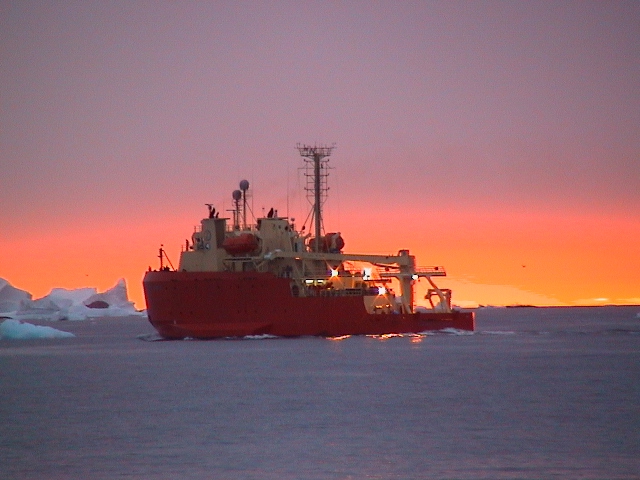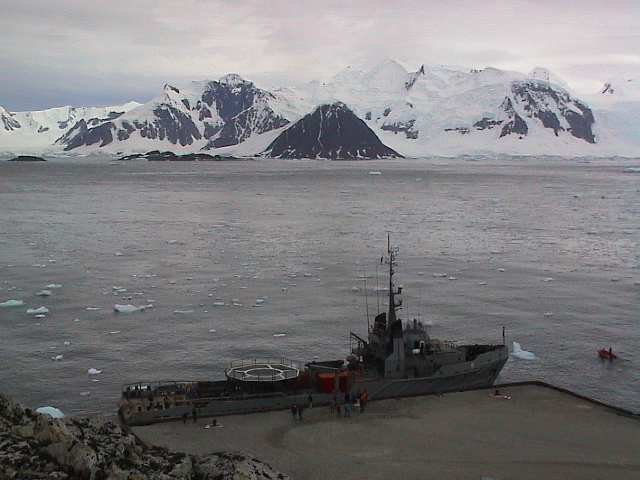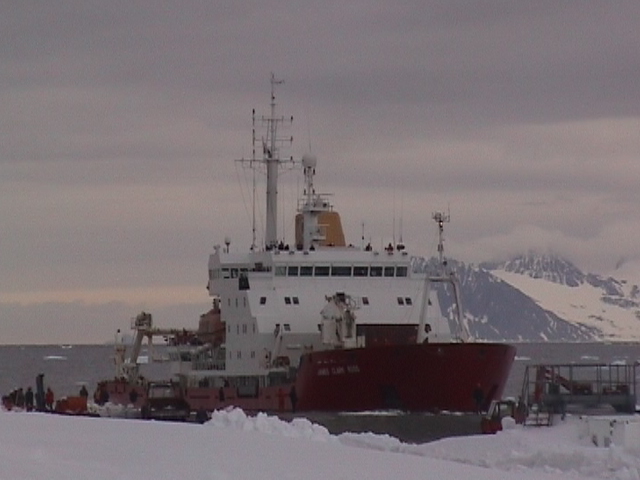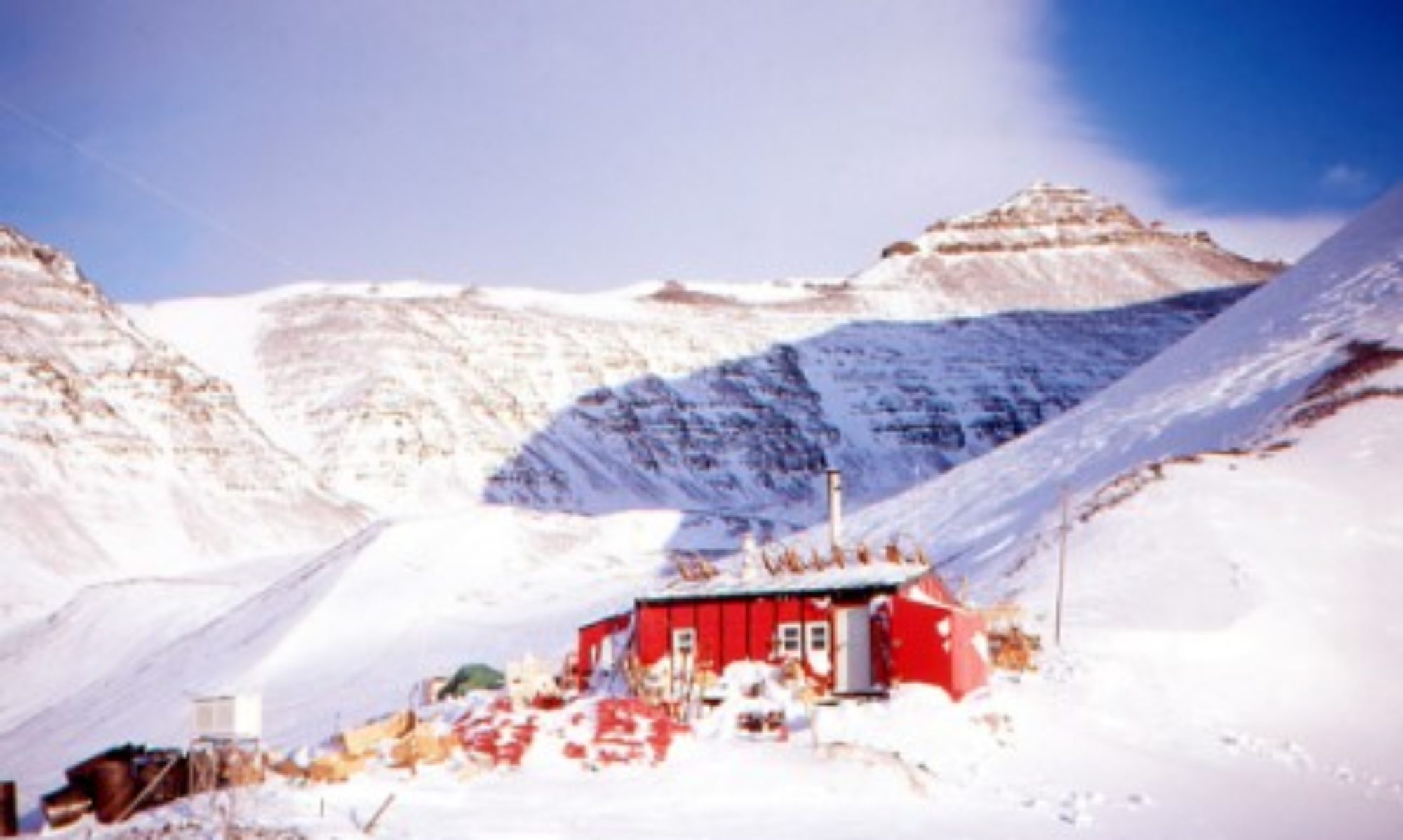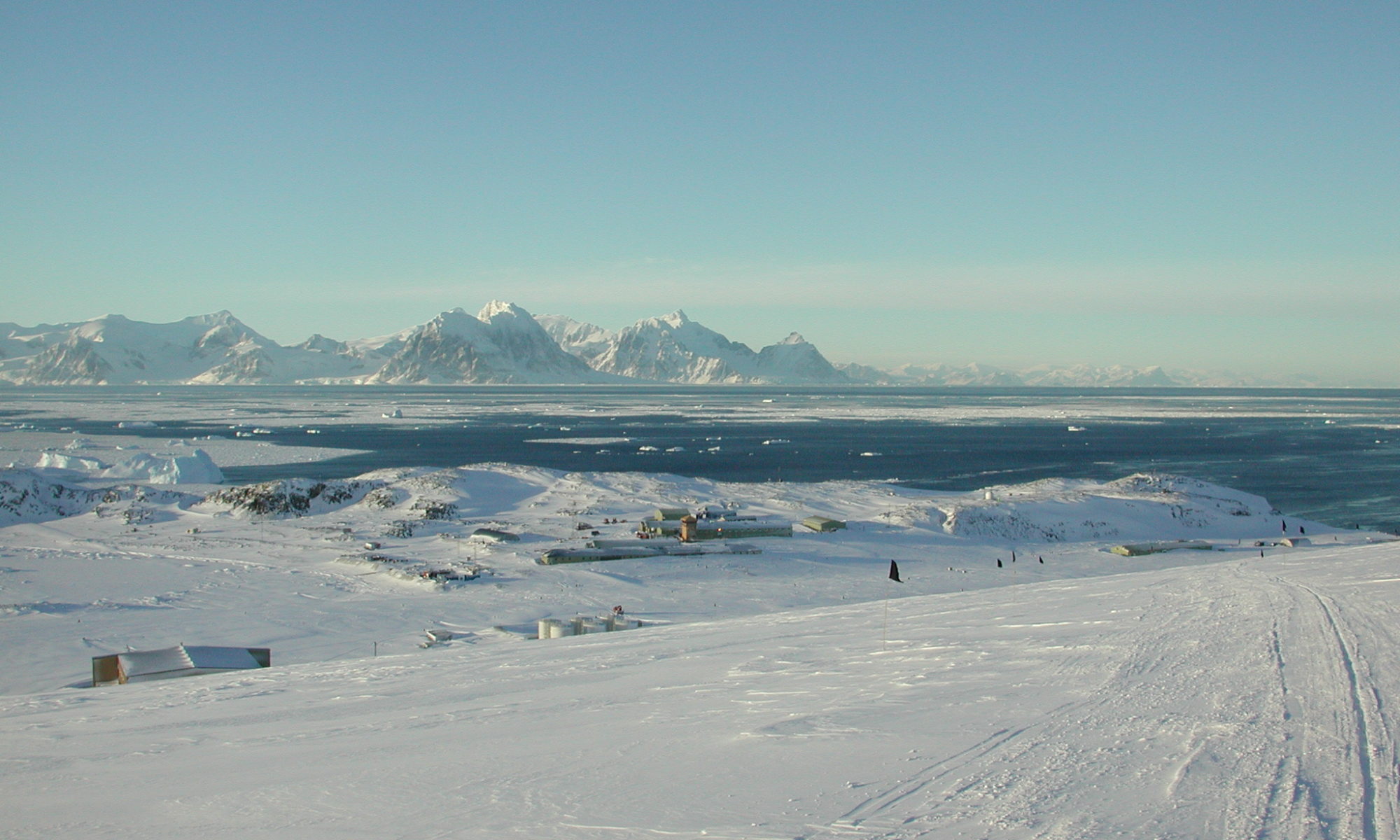History
(Header Photo: Jenny Dean – Rothera in 2001)
The Name behind the Base
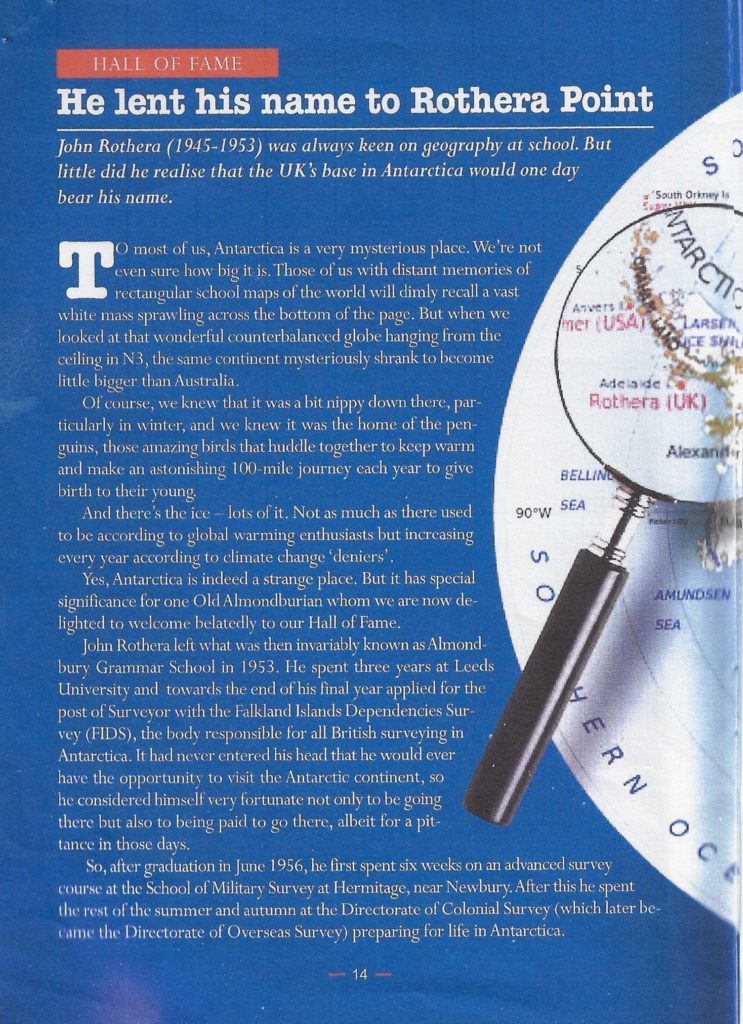
Read John Rothera’s Story Here…
Establishing a new Base at Rothera Point
This account of the three summers prior to the first winter in 1976 is created from fading memories and Base Reports. If anyone sees any errors, omissions or just stupidly wrong, please email comments or corrections to margueritebay.org@gmail.com, together with any additional materials you think might be good additions.
Summer of 1973/74
Deteriorating Skiways at Adelaide and Stonington – Steve Wormald
Because conditions at the Adelaide skiway were deteriorating year by year, during the winter of 1973, Stonington personal moved 800 to 1,000 lbs, comprising 200 Nutty (dog food) and 9 x 45-gallon drums of Avtur (aviation fuel) from Stonington Base to platforms on the dog spans above the Back Bay ice cliffs. In August “when the sun made itself known again”, these stocks were moved the the “Rhamnus” airstrip on the North East Glacier, usually in groups of 2 or 3 dog teams and a skidoo with two 45-gallon drums of Avtur. At the start of the flying season, a two-man tent was placed at the airstrip, with a Squadcal radio for communications with the aircraft, Stonington, Fossil Bluff and Adelaide bases.
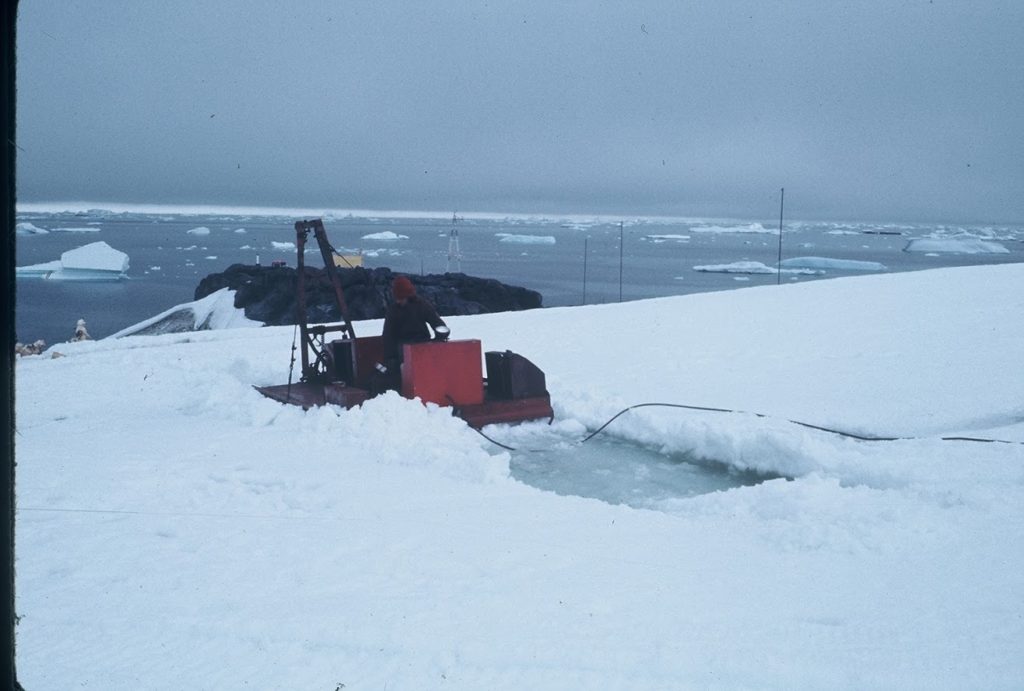
The airstrip at Adelaide was in poor condition for the first few weeks of the season, and Rhamnus depot at Stonington enabled all flights and depot tasks to go ahead almost unhindered, as the aircraft were able to take off ‘light’ at Adelaide and pick up loads from Stonington at Rhamnus. Rhamnus was replenished each time a team or skidoo went from Base to Rhamnus airstrip. Read on...
Re-visiting History – Steve Wormald
During the years after Stonington re-opened in 1961, several Stonington sledge journeys in the northern Marguerite Bay area visited Rothera Point, usually using it as a safe camp site, avoiding camping on unstable sea-ice, and found it to be a convenient meeting point for Adelaide sledges to meet Stonington sledges when heading out to join the Stonington field program on the Peninsula. Some other interesting historic events also took place there – see Stonington 1969 – “The Jones Ice Shelf and The Man in the Moon”.
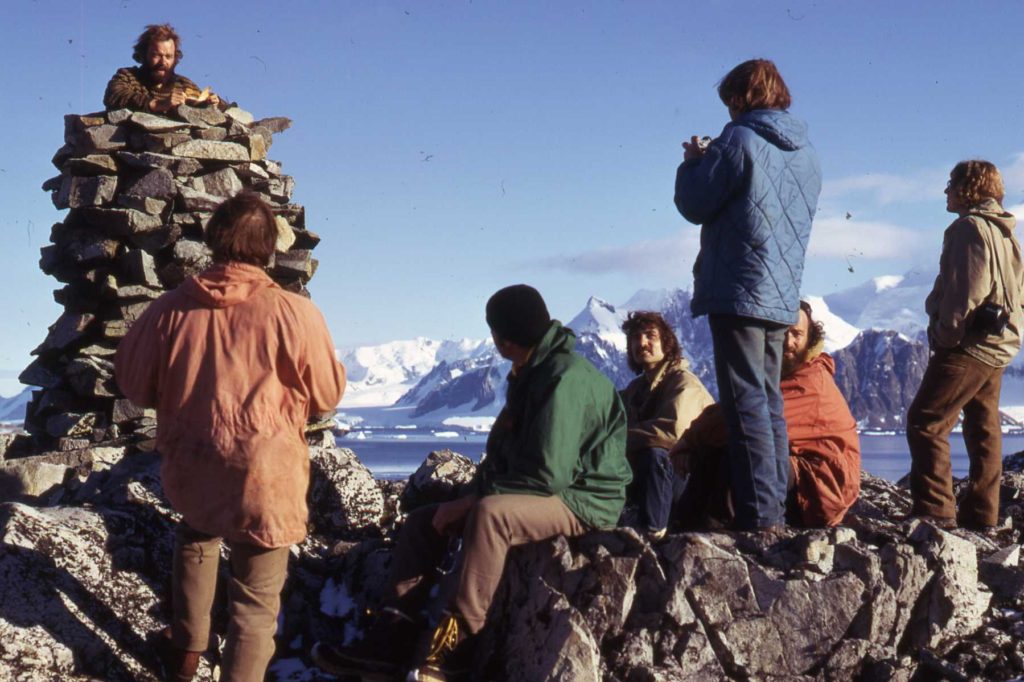
In the 1973/ 74 summer, as agreed with BAS HQ, the Bransfield visited Rothera to take an initial look at the Point with respect to moorings, anchorages with the aim of opening a major air support base there; and as was always the case, outgoing Fids took the opportunity to go ashore and make their own inspection!
There, on the highest point, they visited the Survey cairn installed there, and found this note from John Rothera, describing it as the Adelaide Peninsula” cairn, dated October 30th, 1957. when his survey party were wintering and working out of Horseshoe – Base Y.
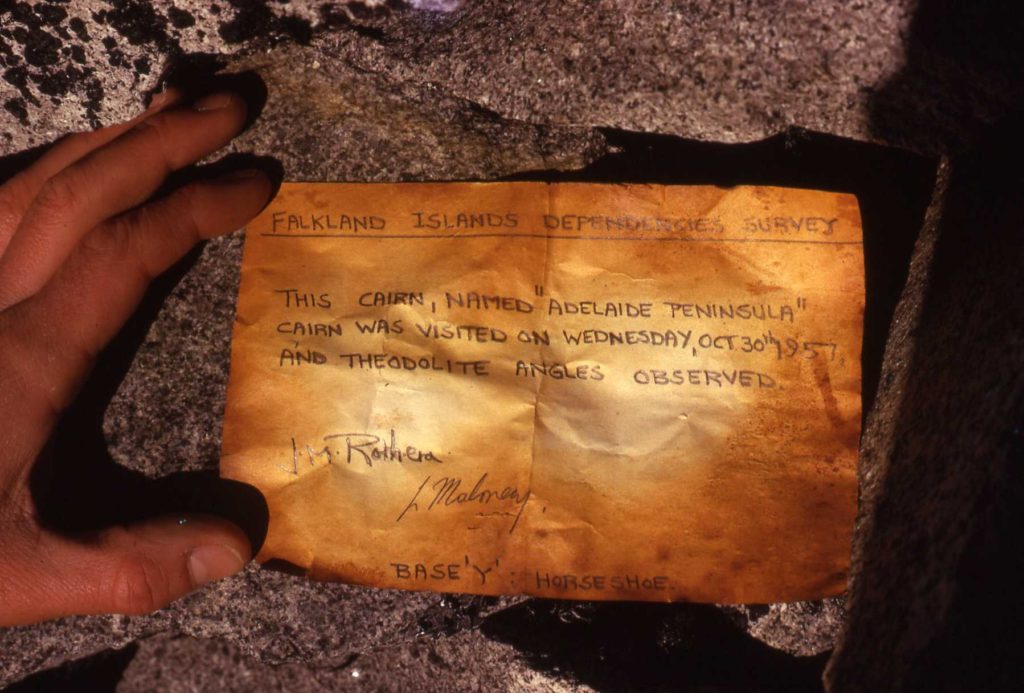
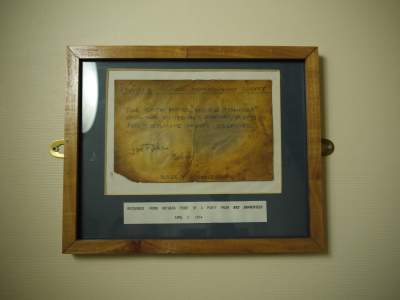
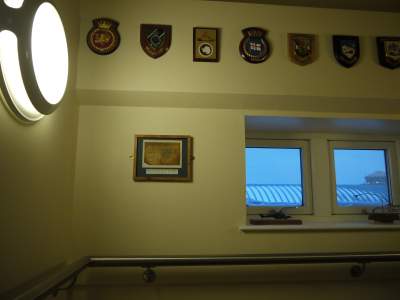
‘Cairn note left by John Rothera and Len Maloney when surveying Rothera Point , 30 Oct 1957, with a note on the backing sheet ‘Recovered from Rothera Point by a party from RRS Bransfield 2 April 1974′. The framed note was, in 2013, behind the Rothera bar, but is now on the stairwell of New Bransfield House.’
Steve Wormald Adelaide – Met, 1969, Stonington – GA – 1970, BC/GA – 1973, Rothera – Ops. Manager 1974-1977
Summer of 1974/75
The Decision to Establish Rothera – Steve Wormald
During the UK summer at BAS HQ, several meetings were held to discuss the problems with Adelaide and the possibilities of opening a base at Rothera. It was decided that we would put in Met and Survey teams at Rothera to properly investigate the viability on all counts for Rothera as the future aircraft support and scientific base.
The two aircraft departed Punta Arenas October 17th, 1974, with Bert Conchie (Pilot), Alec Foreman (Engineer) onboard VP-FAP, and Giles Kershaw (new Pilot – read more about Giles), Alec Simon (Engineer) and Steve Wormald (Field Operations Manager) onboard VP-FAQ. The flight was uneventful in good weather as far as the Argentine Islands. Nothing was seen from then onwards with atrocious conditions even for an experienced Antarctic pilot – violent turbulence, driving snow, 30-40 knot winds and 50 metres visibility. Conditions at Adelaide deteriorated rapidly, and after circling over Adelaide and seeing nothing (except the mast on Avian Island in FAQ’s case), both aircraft diverted to Stonington where the weather was better, but nothing was seen until clear of Adelaide and halfway to Stonington.
The aircraft were picketed at Stonington, and after spending the night on Base, the Air Party flew to Adelaide the next day. Read on….
The Start of a New Era at Rothera Point – Jonathan Walton
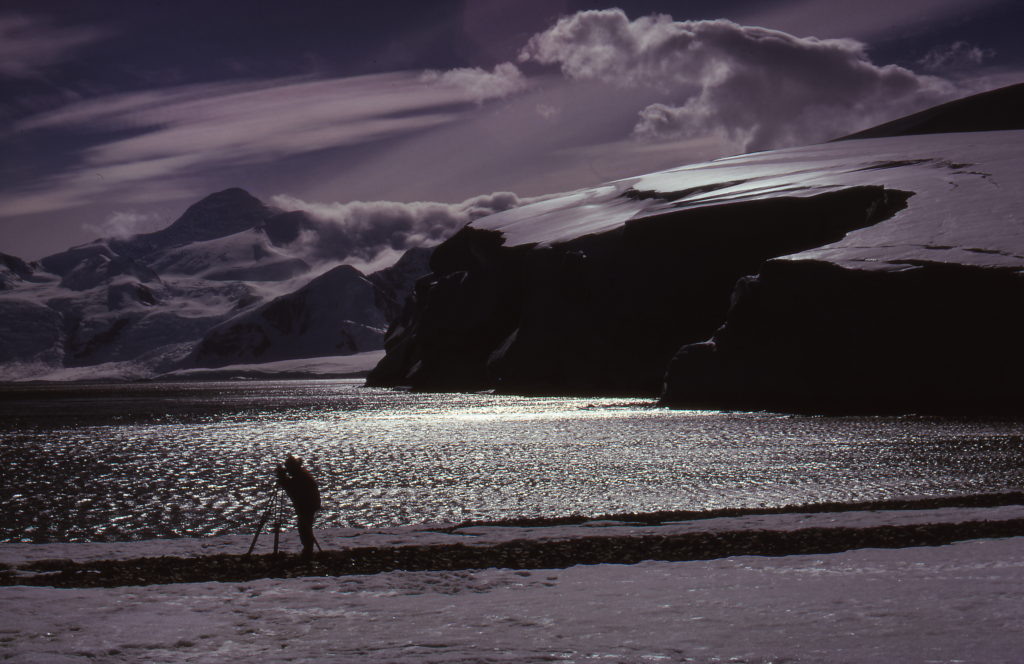
In late January, 1975 I had finished my glaciological work for the season. Most of our work was on or around George VI Ice Shelf and 4 of us had spent the winter at Fossil Bluff. It was the only way to get our studies done as during the summer the surface of the ice shelf became impassable with really soft surfaces, and melt pools several metres deep.
Steve Wormald called me on the radio – it was his first season as Field Operations manager at Adelaide, heralding major changes in scientific work on the peninsula. From now on, most scientists would be summer only, enjoying the winters back in the UK. We had had a great winter at Fossil Bluff – Jim Bishop, Graham Tourney and myself there as Glacios with the indefatigable Rog Tindley as our GA/Mechanic. We travelled large distances during the winter across the mainly flat and mainly safe ice shelf, entirely with Skidoos or our 3 Muskegs (yes 3!, named Fred, Aphrodite and Blodwen). We still retained a link with the days of yore via our elderly pet husky Rasmus but sadly he had died on the 2nd of August 1974, we think the oldest husky to still be active in the Antarctic. Active is perhaps a misnomer – on a good day he could stagger up to high street from the main hut to the garage – his 12th birthday was just a memory for him.
But I digress. It is very easy. Read on….
Summer of 1975/76
The First Hut and Field Operations – Steve Wormald
The intent at the start of the 1974/75 summer season was to rely on aircraft operations from Doumer Island to provide early access to Adelaide for field parties and essential personnel for the work planned for Rothera. The aim was to have a viable wintering building established there by the end of the summer, together with large stocks of aircraft fuel, so that Rothera would be a viable alternative to the rapidly deteriorating airstrip at Adelaide in the 1976/77 season.
After it was found that the airstrip at Doumer Island was unusable, both by aircraft, and by skidoos ferrying cargo, being covered in several feet of soft snow. The John Biscoe and the aircraft carried out recces and decided to move the ferry operation to Damoy Point on Wiencke Island. The cargo planned for Doumer was unloaded at Damoy Point, including the building, 20 drums of aircraft fuel, Read more…..
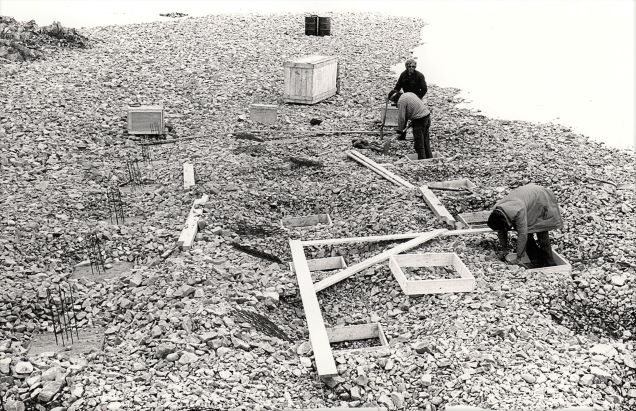
First Winter – 1976
Base Commander – Brian Sheldon
| Horton, C.P. | Builder |
| Hurley, A.J. | DM |
| Sheldon, E.B. | BC |
| Turner, A.J. | Builder |
Winter 1976 – Alec Hurley
The first accommodation hut was erected on 1 Feb 1976 and a 4 man team wintered to complete the living accommodation and deliver aviation fuel to the new ski-way ready for the following field season.
At the end of that Winter, Phase II was built in 1976/77. This included the main accommodation block, power house and tractor shed. This is a story in pictures showing some of the milestones and events during the year.
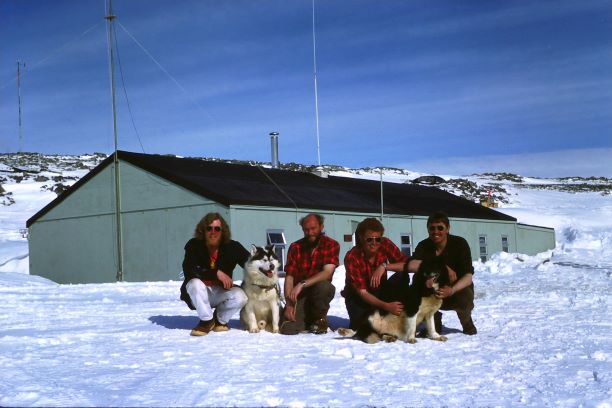
Tractor Journey – Adelaide to Rothera, July 1976 – Alec Hurley
All Photos by Alec Hurley
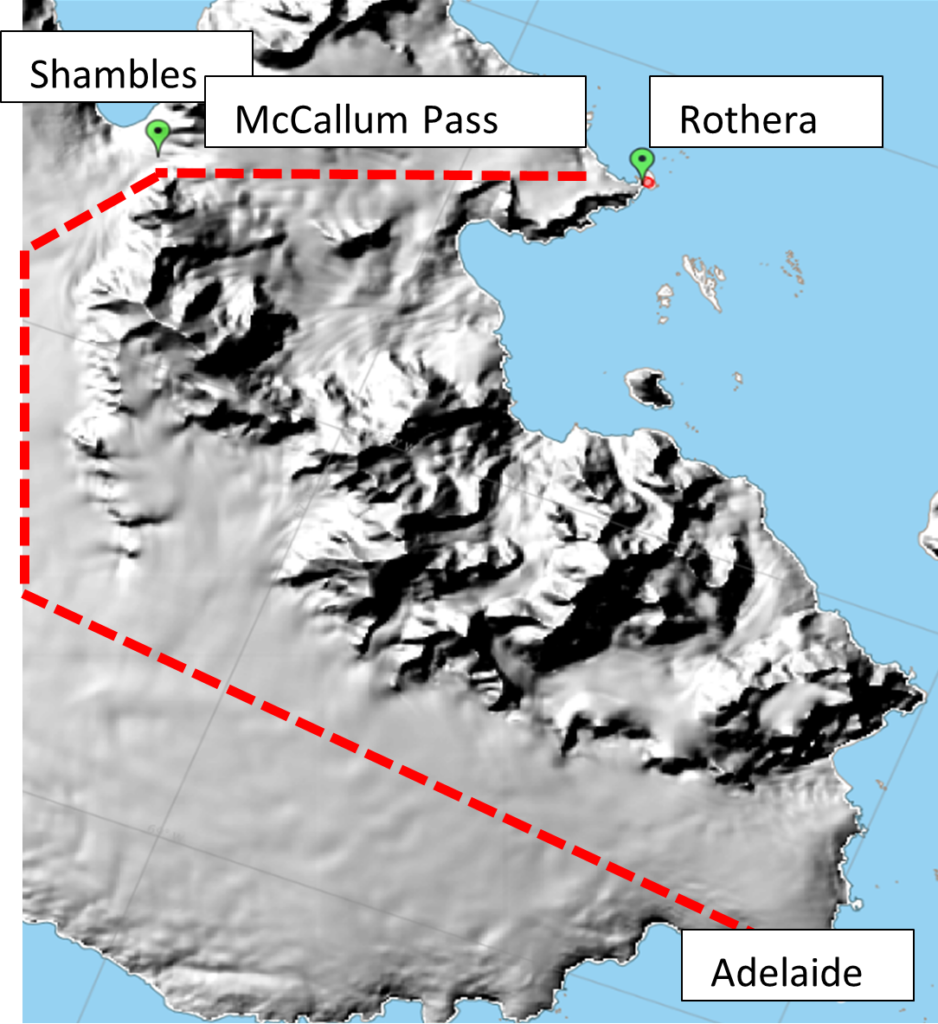
Following a difficult relief at T base the previous season, ending up with the loss of the ‘Magic Bus’ (Muskeg Crane) off the jetty. It was decided to move some of the key machinery overland ready for the Phase II build of the new Rothera base later that year.
July 12th – Heading Out
The Rothera team Brian, Andy, Colin & Alec left early afternoon with improving weather. The Adelaide team, Rob, Trevor, Tony, Don and Dave were already on their way. The plan was to meet in approximately 2 days at the top of the Shambles Glacier. With the light fading, Team Rothera camped at the top of the McCallum Pass, well above the cloud which lay on the Shambles below.
Summer 1976/77 – The Changeover
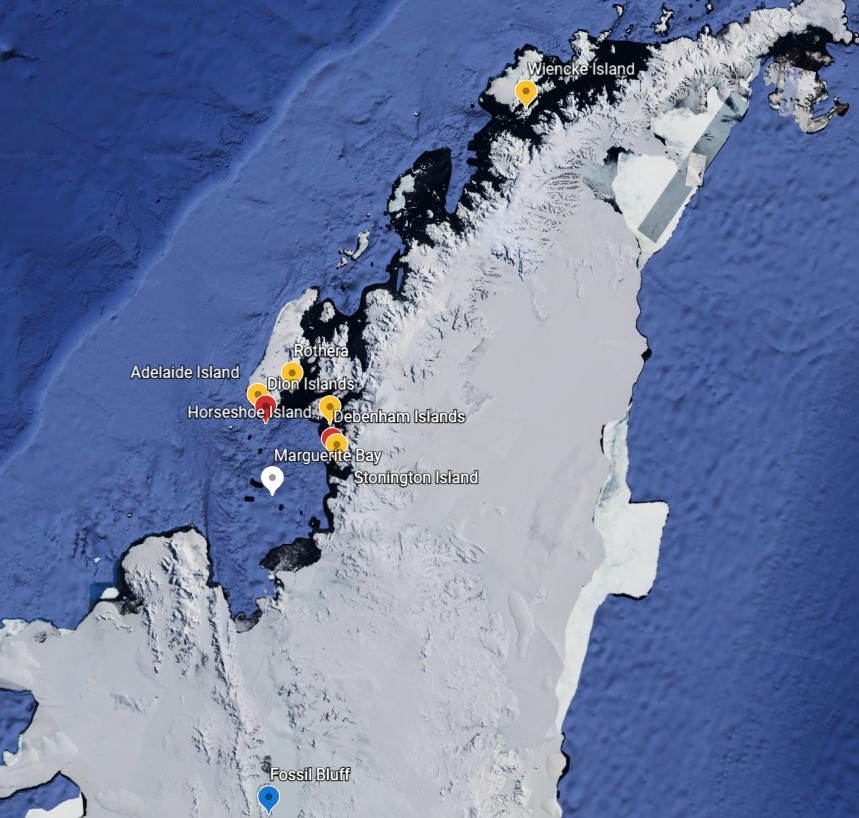
John Biscoe deposited 22 Fids at Damoy again in early November, two days after the two aircraft arrived at Adelaide, where they found the skiway to be virtually unusable due to glare ice and also very uneven. The decision was taken to transfer, prematurely, all aircraft operations to Rothera skiway, to avoid damage to the aircraft. This required flying all personnel, vehicles and field units to Rothera in light loads, resulting in a certain amount of organised chaos at Rothera skiway.
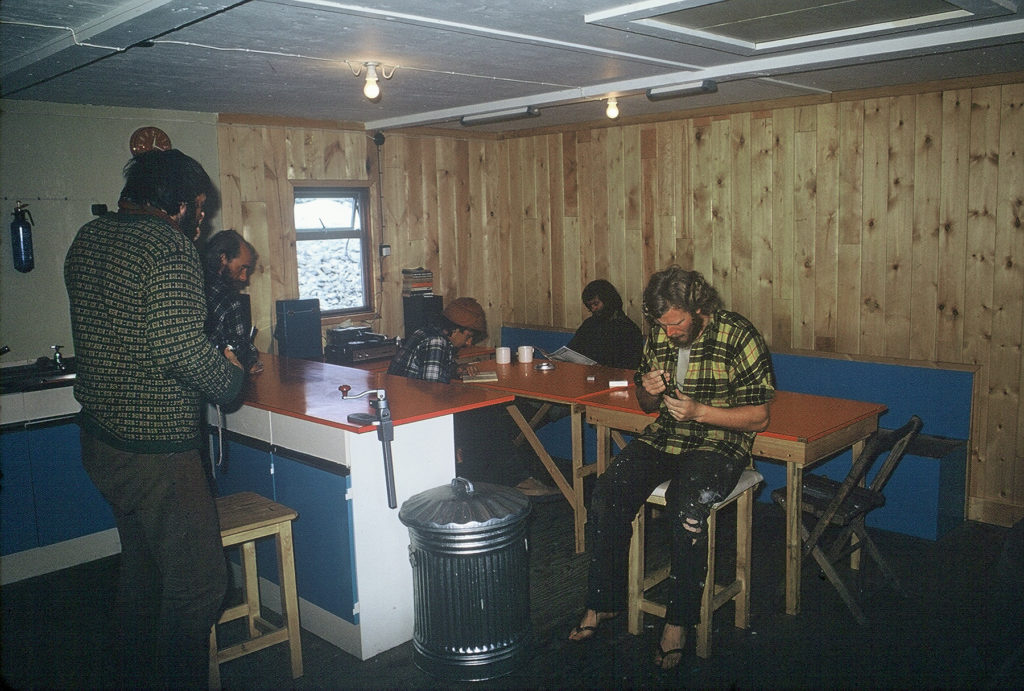
All the priority field equipment was flown direct from Damoy together with all personnel except Mac McManus, Boyle and Ferris, who stayed to man Damoy and continue ferrying loads for the aircraft.
With everything laid out at Rothera skiway in field units, the arrival of the last load coincided with a 3′ snowfall overnight, which completely buried everything except the marker poles; and which also rendered Adelaide’s skiway unusable. The snowfall also made for difficult operating conditions at Rothera, with full power needed just to taxi, and much “crabbing”, which was detrimental to the aircraft. Not a good start to the season.
Geology Adventures on Rothschild Island – Bernie Care
(“Bent Tent,” “Penguins” and “Radio Silence”)

I arrived at Rothera for my second summer-only field season on 13th Nov 1976 via John Biscoe and a flight from Damoy. This was my third trip south: having previously wintered at Stonington in 1974 followed by spring and summer dog-sled geologizing on the east coasts of Graham Land and Palmer Land; before returning to BAS, Cambridge in June 1975 after the decision was made to close Base E and move to summer-only field operations on the Peninsula utilizing skidoos instead of dogs for transport.
My first summer-only trip in 1975/76 had similarly been via ship to Damoy but then a flight to Adelaide Island (as Rothera was not fully operational at that time) en route to the Douglas Range, Rouen Mountains, and Havre Mountains in north Alexander Island with Dog Holden as GA. That trip was successful despite the anticipated learning curves of mechanized travel and frequent maintenance issues, and proved that skidoo travel was as, if not more, efficient than dog teams in terms of geological sampling/mapping achieved. The GAs were less enamored however, as in the absence of dogs they regarded themselves as human crevasse probes, but on the plus side they could now add skidoo mechanic to their resumes!
VP-FAP’s Demise at Gomez Nunatak – Mike Landy
I knew when I joined BAS in 1975 that aircraft operations in polar regions could be dangerous – finding a book in the Scott Polar library detailing dozens of US accidents before I set sail on the Biscoe made that plain. The Adelaide BC Steve Wormald deciding to hold a crash landing emergency practice without telling anyone (except our pilot Giles Kershaw) on my first flight into Adelaide from Damoy served only to emphasise the point. Still, my first season in the Peninsula as a glaciologist went smoothly enough and laid the ground for more ambitious fieldwork in the following year.

Photo: Mike Landy
However the next field season didn’t start well in the Peninsula. In early September 1976 three Fids from our Argentine Islands base (now Faraday) lost their lives while returning from summiting nearby Mt Peary. Then on 15th September an Argentinian aircraft crashed on Mount Barnard, Livingston Island (South Shetlands) while surveying sea ice conditions, with the loss of all 11 on board. A helicopter attempting to recover their bodies was then lost, again with all on board. The dangers of work in the Antarctic were well and truly brought home. But of course you never expect it to happen to yourself.
1977 – Winter
Base Commander – Dog Holden
| Atkinson, Richard (Rick) | GA |
| August, V.A. | Electrician |
| Bateman, I. | Radio Operator |
| Chantrey, M.F. (Mike) | GA |
| Holden, G.A. (Dog) | BC, GA |
| Horton, C.P. (Colin) | Builder |
| Hyams, J.M. | DM |
| Mackay, D.C. (Don) | Builder |
| McManus, A.J. (Al) | Cook |
| Moore, B.E. | Radio Operator |
| Salmon, T.W. (Tony) | Tractor Mechanic |
| Stevens, A. | Builder |
| Sturgeon, L.J.S. (Les) | Geophysicist |
| Toole, B.B. | Tractor Mechanic |
| Turner, P.A. | Builder |
| Western, S.R. | Meteorologist |
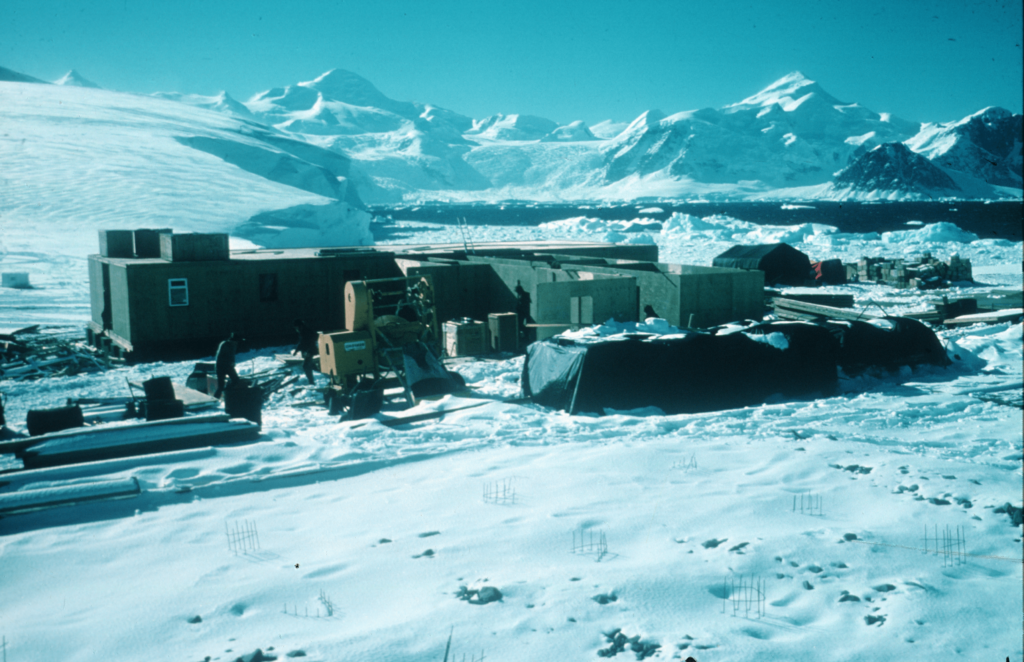
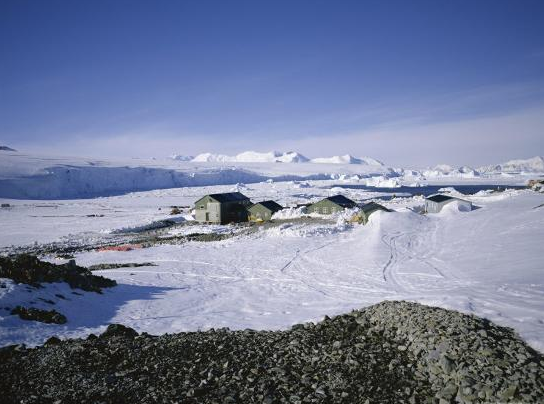
A Seal Encounter – Rick Atkinson
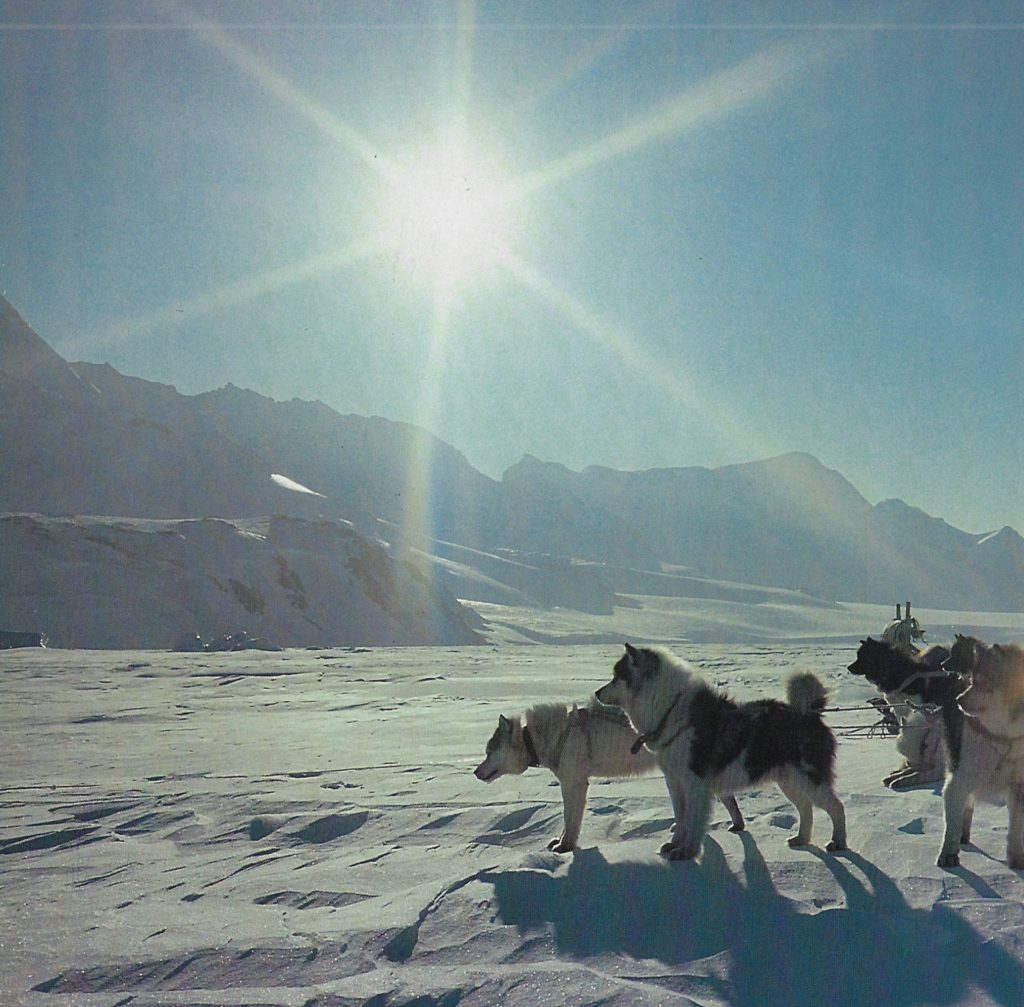
In a land almost devoid of life there are few things that hold the gaze and attention of the dogs like a seal that has hauled itself onto the sea ice.
To the left of this picture a crabeater seal was basking in the sun a few feet from its blow hole. The dogs were aware of its presence for a mile or two before they could see it. Their ears prick up, their pace quickens and their tails rise. The ill-disciplined team will become single-minded about the direction in which they want to head.
There was always an element of risk associated with seal encounters as a bite from a seal could transmit a severe infection.
1978 – Winter
Unexpected Winter at Base del Ejercito, General Belgrano I, Filchner Ice Shelf:
The realisation that we were stuck at the Argentinian Base Belgrano 1, on the Filchner Ice Shelf dawned on us slowly. Hopes of rescue had faded over several weeks. However, stuck we were, and it looked as if it was going to be a long, cold winter. And so, it proved to be!
Arrival at Belgrano:
“We”, were three Fids; John (Youth) Wright, a Halley G.A.; Phil Marsh, a Geologist (summer only or so he thought!) and me, Dog Holden, a Rothera G.A. and B.C.
Youth had wintered at Halley in 1977 and prepared the gear for 2 x 2 geology sledging parties for the 1977/78 summer season in the Shackleton Mountains. I had been at Rothera winter 1977 (after wintering at Stonington Island and Adelaide Island bases in ’74 and ’75) and Phil Marsh, was flown into Rothera in Spring ’77 as was the Senior Geologist, Peter Clarkson.
Pete, Phil and I flew into the Shackletons from Rothera (via Belgrano) in November 1977 and Youth was flown in with the gear from Halley. We all had a great field season in the Shackletons.
Although colder, at 81°S, the weather there was much more stable than that of the Peninsula and there were a lot fewer crevasses too!
Base Commander – Kenn Back
| August, V.A. | Electrician |
| Back, E.K.P. (Kenn) | BC, Meteorologist |
| Brindle, J. | Builder |
| Cheshire, A.A. | Radio Operator |
| Hall, A. | Cook |
| Jewell, J.A. | GA |
| Johnson, C.E. | GA |
| Lee, B.P. | DM |
| Sharp, M.C. (Mike) | GA |
| Stevens, A. | Builder |
| Tickle, A.N. | Tractor Mechanic |
| Young, N.St.J. | GA |
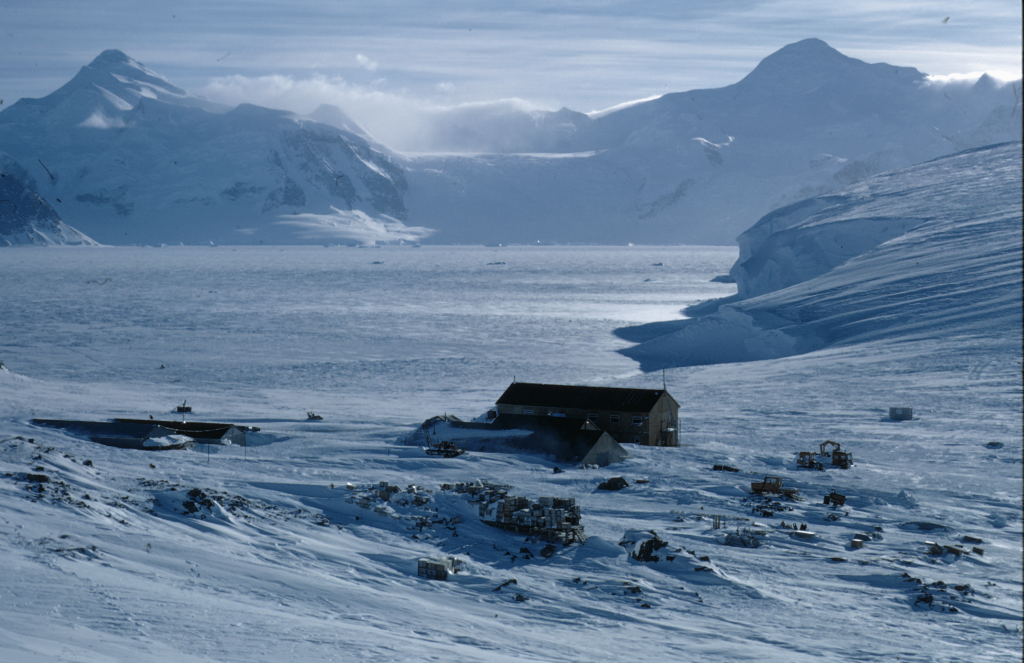
1979 – Winter
Base Commander – John Jewell
| Airey, R.F. (Rick) | GA |
| Davies, M.C.B. | Tractor Mechanic |
| Dunn, S.S. | Meteorologist |
| Escott, A.J. | Electrician |
| Fogg, T.D. | GA |
| Howell, L.J. | Radio Operator |
| Jewell, J.A. (John) | BC, GA |
| Jones, Stuart M. | DM |
| Somers, G.U. | GA |
| Tickle, A.N. | Tractor Mechanic |
| Turner, A.J. | Builder |
| Young, N.St.J. | GA |
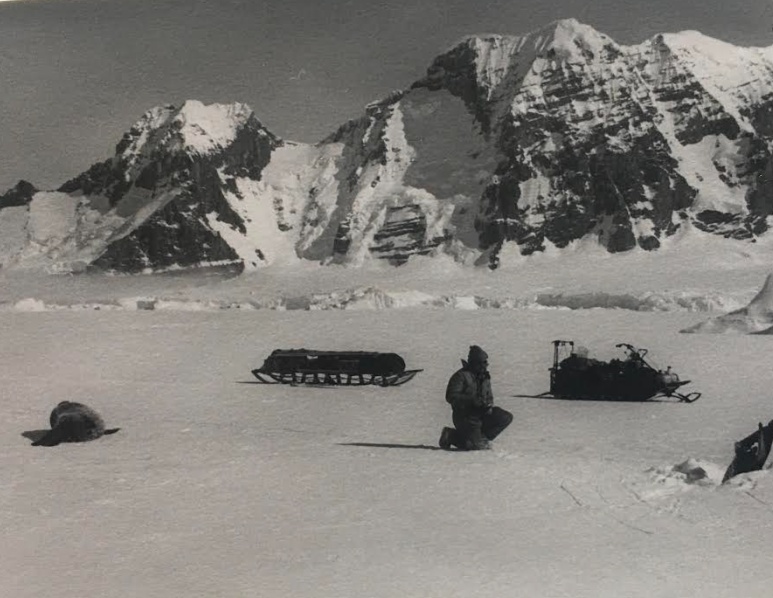
A Journey to Detaille Island – Base W – Rick Airey and Geoff Somers
Some interesting extracts about problems involved in sledging in the area around Rothera and the value of having the refuge hut at Detaille Point.
They had one team, the Picts; Yvonne, Fergy and Malky, Jason and Dingle, Helix and Boot, Lomond and Lil, with one sledge. Yvonne had been trained by Geoff and he was very proud of her.
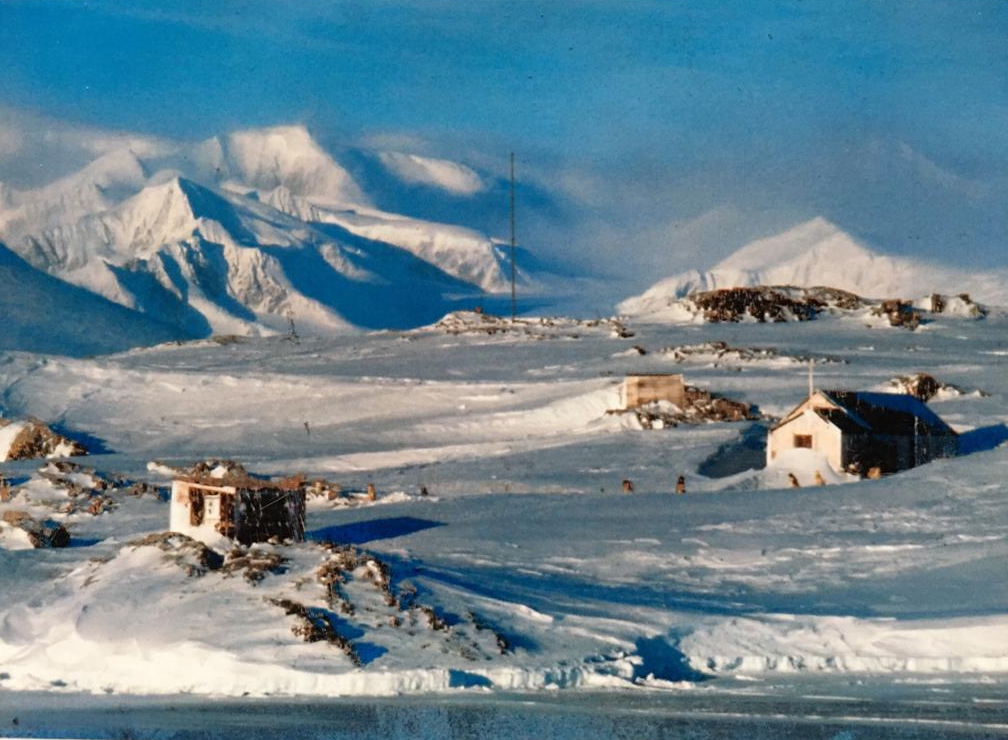
July 24th. Very fast run to Blaiklock Island in strong Northerly winds easing towards evening.
July 25th. Half way up Heim Glacier stopped by very high winds and after 4 hours delay in a pup tent waiting for better weather we had to camp on hard glare ice in 50 knots of wind and no snow to drift over the dogs.
July 30th. (after 4 days lie up in conditions that involved remaining fully dressed) Left dogs and sledge to find route through very difficult area. Working with 150 yards of rope and a deadman we negotiated the bad area with the dogs very quiet and well behaved somehow understanding the problems.
July 31st. Snow so deep and soft that the sides of the trench made by the lead dogs kept on falling in on poor Lil at the rear
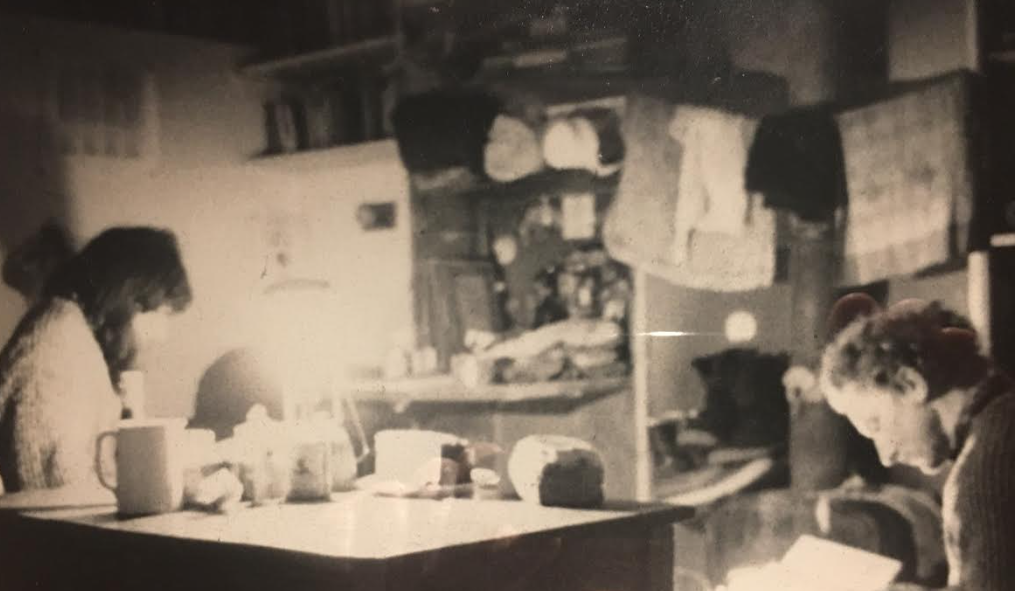
August 4th. Rain and deep soggy snow on 3 year old sea ice with bergy bits very well covered as well as large tabular bergs completely rounded off with drifts on all sides.
August 5th. Reached Orford Cliffs Refuge which had not been visited for 13 years.
August 7th to 21st. Day of very high winds reaching 100 knots Very interesting dis-interring much food, almost all useable and we enjoyed warmth and security in winds that would have been very uncomfortable if we had been camping.
August 25th. Finally reached Blaiklock after difficult 10 miles in complete whiteout.
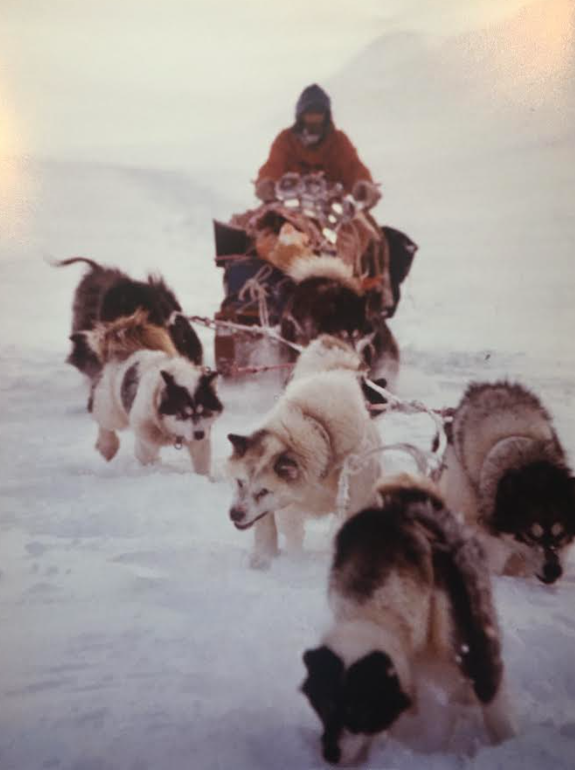
August 27th. Left Blaiklock but forced to camp on NW corner of Pinero Island. We were joined by sledge Party Papa who arrived, (on motorised transport !) an hour after us.
August 28th. Up at 0530 and away at 0700, hoping not to wake Sledge Papa. ‘shushing’ and whispering to the dogs. The machines only caught us up a mile or so from Rothera. The dogs behaved superbly on arrival driving to the sledge store to unload and then down to the spans without a gremlin and with a very critical audience.
Great reward for Geoff who had worked so hard on Yvonne.
Ric Airey, WOM South Georgia 1975, WOM Rothera 1976, GA Rothera 1979
In each of the ten years I had the good fortune to spend in the polar regions, the best bit was finding companions of equal or greater ability to enjoy journey’s which some might not reckon sanest of options but a delight to the soul if you can live to tell the tale, suitably improved with Age.
Ric Airey – 2020
So, to read the full story, retold and modified with age, and suitably translated from the original “Airey-ese”, read on HERE
Ric Airey also returned to Rothera some years later – see 1984/85
The Doggy Song – Geoff Somers – GA, Rothera, 1979
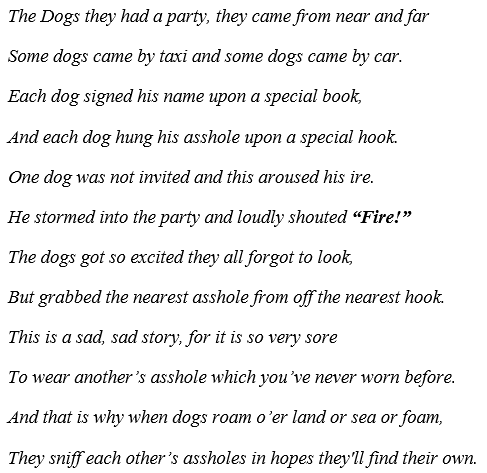
1980 – Winter
Base Commander – Alan McManus
| Artis, Steven | GA |
| Bowler, R.E. | Tractor Mechanic |
| Cox, N.I. | Carpenter |
| Duncan, Rodney | Medical Officer |
| Escott, A.J. | Electrician |
| Hadley, N.T. | Tractor Mechanic |
| Howell, L.J. | Radio Operator |
| Jaques, M.R. (Mike) | GA |
| Jones, Stuart M. | DM |
| McManus, A.J. (Alan) | BC, Cook |
| Nicol, C.D. | Assistant Glaciologist |
| Somers, G.U. | GA |
| Sturgeon, L.J.S. (Les) | GA |
A Practical Joke – Nick Cox
Mac, Nigel and I were the only people on base. Some were at Blaiklock and some were trying the centre gulley on Leonie. All were expected back today. We have had quite a good run of practical jokes on base recently and during lunch an idea weaved in my mind. Mac and Nigel watched while I rolled some slices of bread in my hands until they made a soft dough. I put some black treacle in a cereal bowl and rolled the dough in it. I pulled out a lump and rolled it like plasticine between the palms of my hands. The result was a perfect imitation puppy dog turd, black, and pointed at both ends. Mac and Nigel soon entered into the spirit of things and we rehearsed the joke we would play on the others at tea time. Before returning to work we left the turds in position behind a box near the sitting room door.
Tea time conversation was particularly noisy, the table crowded with the wind blown, red and brown faces of those who had been out in the field. The six pups ran round the dining room floor as they always did at tea time. Charging around unsteadily, often tripping onto their chins; stopping for practice growls and fights. Occasionally one was scooped up and cuddled by someone at the table before being launched onto the floor again. On cue, Nigel got up to get some cigarettes from the sitting room. At the door he paused and said in a long drawn out way ” Oh Nick, there are some turds over here behind this box”.
“I’ll clean them up Nigel ” I called cheerfully.
I followed the normal clean up routine which involved picking up the turds with bits of cardboard box, flinging them in the gash bucket then washing the remaining mess off the floor using the mop and bucket which stood by the wall.
Nigel was back at the table, nonchalantly tapping the end of a cigarette on the packet, when I walked by holding a scrap of cardboard with the little pile of turds perched on top. Nigel grinned as he challenged me “I bet you wouldn’t dare eat one of those turds”. I stopped in my tracks and looked thoughtful. As sudden as a needle removed from a noisy record, the whole table went silent; all looked on, – hooked. “What do you bet” I asked defiantly.
“Three cases of beer” Nigel cajoled.
The silent audience watched wide eyed in disbelief as I held my outspread fingers with turd attached nervously in front of my face. I studied it carefully before pushing it slowly and awkwardly into my gaping mouth.
The reaction from the onlookers was immediate and explosive. Horror-struck faces, bewildered, jaws hung open, some with tongues out, tugging on their roots. A loud mixture of groans and moans with a list of statements of horror and disgust: “Oh, no”.
“Disgusting”. “How could you”.
“You dirty bugger”. “He’s off his rocker”,
and of course from Bob Bowler “Burcko, he’s bloody burcko”.
It was a tremendous success. Mac, Nigel and I watched the groaning and writhing mass with satisfaction. By this time most were simply groaning while nesting their faces in their arms on the table.
After the lunch time rehearsal I had a suspicious thought. There being no honour among accomplices, it was not unheard of for practical jokes to backfire. I would not have put it passed Mac or Nigel to exchange the imitation turds for real ones taken from the pup pens. The last laugh would be on me if I ate one. I stole back up to the dining room where I plucked a hair from my head and carefully placed it across the turds. I would check it was still there when we came to act out the joke. I got the idea of the tell tale hair from a James Bond film. But it must be said his motives were slightly more glamorous than mine.
Fixing Dex – Nick Cox
With the dogs spanned we fed them two blocks of nutty each. We are using a borrowed sledge; I am in the process of rebuilding mine. We had checked the night trace but had not noticed that some of the chains are too long. Mac and Dex could just touch noses and began to fight. Mac got hold of Dex by the nose, his jaws clamped tight. Mac immediately adopted that superior, blank, glazed stare. Like a wrestler who has his opponent in a perfect hold, enjoying the moment at the expense of the others discomfort. Poor Dex squealed with pain, his eyes focusing all too closely on the line of teeth across the bridge of his nose. We freed Dex by inserting the back end of a ski between Macs jaws, levering them gently open.
The fracas over, both dogs looked very pleased with themselves. Both sitting and wagging their tails with gusto while looking alternatively at me and each other. Mac had a big grin on his face, a string of blood stained saliva hanging from one side of his mouth. Dex was also grinning. There was a large hole on the bridge of Dex’s nose, right between his eyes, the displaced flesh standing on end like the jagged top of a newly opened baked bean tin.
Old Dogs – Nick Cox
At last a downhill run. The slope was steep and the dogs were enjoying having no tension on their harnesses. A dog collar round each runner helped slow the heavy sledge down. I stood on the sprung ash plank brake, the metal teeth digging deep and throwing a large thick cloud of snow in our wake. Twice Twiggy fell, his short cabriole shaped legs could not take the pace. We lifted him on top of the sledge load for the remaining journey down the hill. Twiggy is eight years plus now and should be put down before too long. It is sad to see a dogs working life over, like an old wolf, the process of aging towards the end of their ‘life accelerates as the ability to keep up with the pack and hunt food decreases. A sledge dog at eight often finds keeping warm a problem. Walking from the sledge store to the spans at base on a cold day it is sad to see an old dog which does not jump and greet you like the rest because it is loath to lose the heat accumulated during the time spent curled up. Old dogs often have blunt teeth, squared off by chewing on the iron hard blocks of seal meat. I am sure they would not thank us if we prolonged their life by keeping them warm indoors fed on minced food. They are proud working pack animals, they have a happy fulfilling life, when their days are over I am sure they are glad to go quickly.
Magazine in the Nutty Box – Nick Cox
We hauled one of the heavy boxes of dog pemmican out of the snow and prised the plank lid off. The nutty blocks in their white paper wrappers were neatly stacked in two rows, edge downwards. This particular box was very unusual. Years before, when it was packed at Bob Martin Products in Oldham, someone had folded a 1963 copy of Playboy magazine in one end as padding. I could hear whoever it was, saying “That will cheer the boys up down there”. It made an odd scene, both with anorak hoods up, backs to the wind, ogling the magazine. We could not look long, the poor dogs impatient to be fed, barked loudly on their chains.
Eating While Drivinq a Dog Team – Nick Cox
Crossing Calmette Bay was like crossing a large bowl of white sugar. We seemed to make little forward movement at all. The dogs had no more than their heads and backs showing above the snow at times. They worked magnificently; always eager for a rest, but always eager to start again. I cheered, chided and encouraged the team along. Sometimes calling the name of a down spirited individual and sometimes words of encouragement to them all. It was well into the afternoon and I was feeling hungry. I rummaged with one hand in the sledge bag hanging from the handlebars and found the packet of Rollos I was hunting for. With one hand and shoulder I pushed at the sledge, desperate to keep the sledge and team moving as long as possible. With large leather mitts on I was not at all dextrous and could not unwrap the Rollo packet. Eventually I resorted to tearing the wrapping away with my teeth. A Rollo fell to the ground, so I hastily pushed them all into my mouth as fast as I could. My cheerful chanting was immediately reduced to a wet brown, chocolaty, gurgle. I was almost asphyxiating on Rollos. The dogs of course stopped and looked over their shoulders. I could see their half grins. I felt such an amateur.
Dogs Feet & Snow Gombles – Nick Cox
Below -400C the snow is often quite hard and granular like builders sand. The dogs feet are quite sore: some I see have been bleeding between the pads. When we halt they turn their paws upwards and pick at the ice between their pads very carefully with their incisor teeth. Some are adept at clearing their paws while on the run. They throw themselves forward, skidding along on one shoulder, pushing forwards with their back legs, while nibbling at the underside of their front paws. During a halt some of them push their backsides into the snow and half recline with all four paws lifted off the cold granular surface.
Dogs Fighting (A Bundle) – Nick Cox
The dogs were a bit irritable earlier but cheered up when the sun came out; everything look magnificent. We met a large tide crack which at first looked impossible to cross. I had to run and jump with Giles the leader. At the other side the following dogs landed on top of us. The whole team was like a compressed concertina. A bundle followed, but it was mostly a shouting match. The main offenders could be called out by name. Untangling traces took quite a while, unclipping one dog then making him sit while I unwound his trace from the others. We were all thoroughly enjoying it. We reached Stonington two hours after leaving San Martin.
Mary In Season – Nick Cox
The dogs were not pulling particularly well, a lot of grumbling going on among the boys. I ran-alongside them for a while but they would not cheer up. The distraction, I knew, was that Mary was coming into season. Suka and Porthos, normally good friends, made low growls at each other, Martin at the cow catcher was making a great effort to catch the back pair by the heels. Even Giles the leader was casting jealous glances over his shoulder.
Seal Chop – Nick Cox
This afternoon Bob, Colin and I cut up five seals; making 182 feeds. The dogs receive a 51b block every two days. amount seems small compared to the diet of their domestic relatives who feed, often excessively, every day. Like many wild carnivores a hunt and a feast is followed by a long fast. The Greenland dogs seem to do well on it.
Colin cut the frozen seal carcass into manageable portions with a chainsaw. First the head then shoulders and so on cutting it into ten inch thick discs all the way to the tail.
The poor seals shape remained; but could be dismantled and reconstructed like some macabre giant toy. The logging over, Bob and I rolled each disc away and lay them flat on the snow. The discs were indeed very like wood logs, but instead of a clear cross-section of bark, pith, growth rings and medullary rays, there was skin, blubber, muscle and bone, We used felling axes to cut the discs into 5 pound blocks. To remind us of the correct weight, a 5 pound caterers tin of Plumrose Ham lay near-by which we jostled in our hands occasionally.
We do not feed the dogs seal heads and tails in the winter, they have little meat on them and frozen rock hard are neigh on impossible for a dog to chew. In the summer months we remove the skin and blubber which goes soft in the warmer temperatures and mats the dogs fur.
Dog Escaping on the Spans – Nick Cox
I was hanging up Giles harness when the dogs on the spans began to bark and sing. In the dim light I could see a loose dog running about. I ran over to find it was Boot. He had done no harm and returned in good humour to his chain. The chain swivel on his collar is not near enough to his neck where it would receive heat from the dog and be less likely to freeze, allowing the clip to come loose.
Boot got off last Saturday night causing the dogs to sing their tell tale alarm. Steve and Mac went over, but could find no loose dog until they began to walk away when Boot ran after them. He had been running in circles over his chain even though he was not attached to it.
Pan of Seal Meat in the Base Meltwater Tank – Nick Cox
There has been an increasingly bad smell coming from the melt water tank during the past few days. It became so repugnant that even those with the strongest constitution began to complain about washing, cooking, making milk and brushing teeth with it. We drained the tank to find a large Aga roasting pan piled high with fluffy rotting cubes of seal meat. Tony and I are keeping a low profile.
We collect seal fillet steaks which we mince for the younger pups in the pens. It has become increasingly difficult to find somewhere to thaw the meat. The dog room is below freezing and we have been banned from most other places with a reasonable temperature. We were caught hiding pans of meat in the genny shed weeks ago. We had forgotten about the pan of meat in the boiler room. Someone had obviously found it and in disgust had thrown it outside the back door. There it got snowed under during the recent bad weather. The area is ideal for snow blocking. Someone threw a cube of snow containing the pan of meat through the hatch into the heated melt tank where it began to rot, making a none too popular soup.
Feeding Dogs Nutty – Nick Cox
The dogs are fed 450gm blocks of Nutrican dog pemmican during a journey. Each dog receives one block a day for two days and two blocks on the third day. The food provides an average of 3,300 calories per dog per day. They eat snow to rehydrate themselves. When thirsty their fur becomes stiff; well hydrated, their fur is silky. On the first day of a journey we remove the thin paper wrapper from each block of
pemmican so that it does not clog with the seal meat and bone remaining in their stomachs from the last meal they had on base. The second day out we walk down the night span chucking each dog a paper wrapped block. The dogs pounce on the welcome food. Most crunch up paper and pemmican and swallow it all. Some stand over the block, front legs straight, pressing it into the snow with front paws while carefully removing the paper with their incisor teeth. The wrapper is discarded; and the block consumed. Isobel, I have noticed, goes to the trouble of removing the wrapper then eats it as a starter before the main pemmican course.
Nick Cox, Carpenter, 1980
1981 – Winter
Base Commander – Mark P.D. Lewis
| Anderson, J.H.M. | GA |
| Atkinson (Robert) | Cook |
| August, V.A. | Electrician |
| Godsmark, T. | DM |
| Gregory, C.R. | Builder |
| Griffiths, A.P. | Medical Officer |
| Hadley, N.T. | Tractor Mechanic |
| Hawkins, A.C. | Radio Operator |
| Lennard-Jones, P.J. | Meteorologist |
| Lewis, M.P.D. | GA/BC |
| Summerson, R.M.V. | GA |
| Tait, S.R. | GA |
| Tickle, A.N. | Tractor Mechanic |
A Third Marguerite Bay Travel-Related Accident
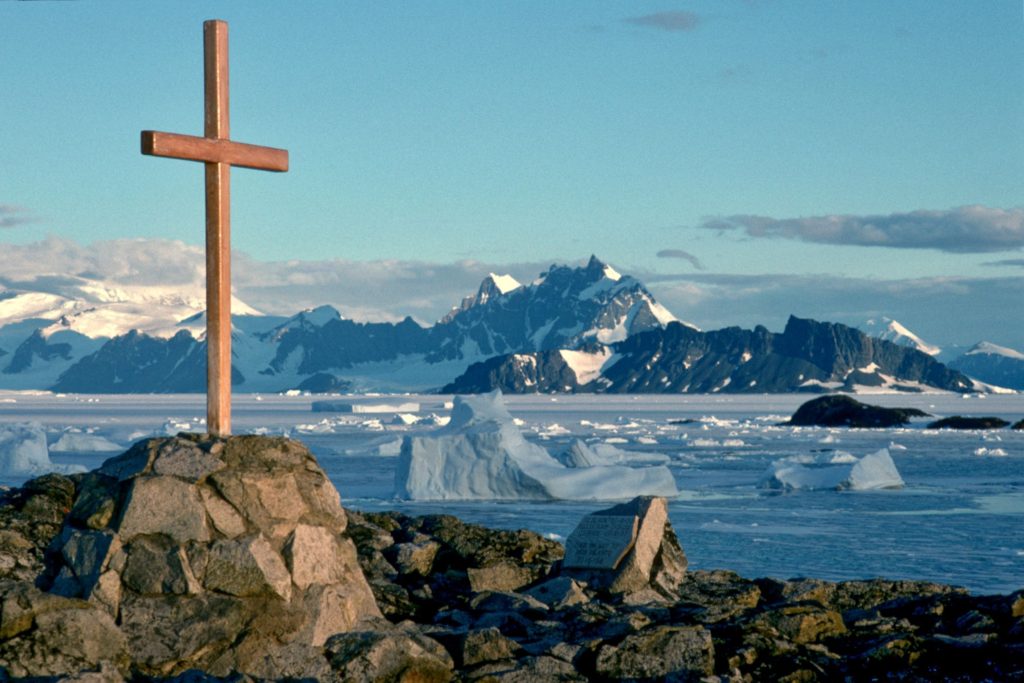
(Photo: British Antarctic Monument Trust)
Three travel-related fatal accidents have occurred in Marguerite Bay since the first exploration by Fids in 1946.
When teams were visiting the Dion Islands in 1958 with dog teams for survey depot laying purposes from Horseshoe Base, three Fids were lost when the sea ice blew out while travelling – related on the Horseshoe page, 1958, and also on the Stonington page. A Memorial plaque is situated at Rothera.
Two Fids were lost when traveling for recreational purposes with dog teams from Stonington in 1966 near the Northeast Glacier in The Trough area, when a major windstorm caught them out of their tent – related on the Stonington page, 1966. A Memorial cross is situated at Stonington.
Two Fids were lost from Rothera in 1981 when travelling on skidoos for recreational journeys. A Memorial cross is situated at Rothera. Here is the story:
A Fatal Skidoo Journey – Rothera 1981
The Background Story

Ski-doos (“skidoos”) and various other mechnical methods of travel had been experimented with for many years – Fox-Tracs at Adelaide for travel to and from the airstrip, Eliasons (aka Elsans) – see Eliasoneering”, by Pete Kennett, Stonington, 1963; and various iterations of actual “ski-doos”.
Ski-doos had been used successfully for many years for field work from Fossil Bluff, mostly on the relatively safe King George VI Sound, and also had been used for cross-plateau trips, typically accompanied by (and on a couple of occasions, carried home by) dog teams from Stonington – see Dave Singleton’s stories in 1972.
The following stories are from the slides and diaries of Steve Garrett combined with those of Bruce Herrod. Both were hired by Geoff Renner in 1981 to perform regional geophysical surveys across West Antarctica. Subsequently, Bruce died during his solo descent from the summit of Everest during the landmark summer of 1996. His partner at that time, Sue Thompson, has kindly provided his images and diaries together with her approval of the stories
In Praise of Damoy – Steve Garrett
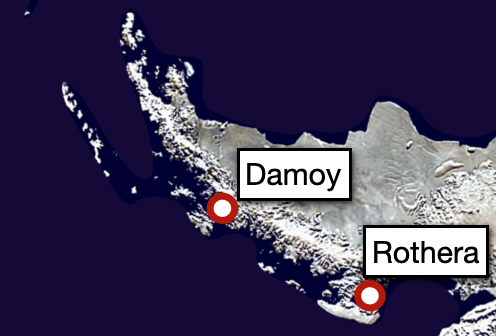
Sea ice prevented RRS John Biscoe from reaching Marguerite Bay at the start of many field seasons (see “Abandon Ship” in 1985). The BAS solution was an airlift of people and equipment to Rothera from Damoy on Wiencke Island opposite Anvers Island.
Damage to BAS Twin Otters VP-FAW & VP-FAZ AT ROTHERA
(Extracted from BAS Report by Gary Studd, Chief Pilot – BAS Air Unit)
HISTORY
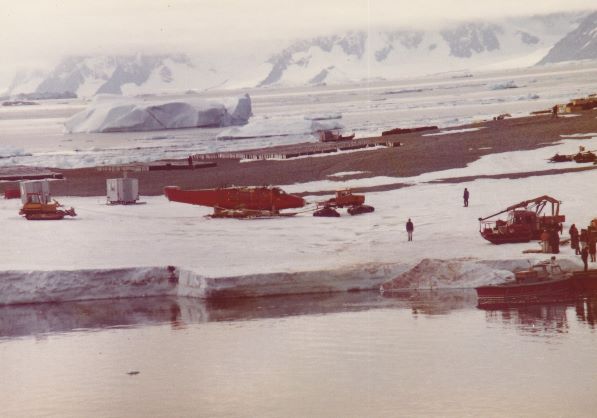
Both aircraft were last flown on 14th November 1981 , after which they were both refuelled and tethered on the tie-down points at Rothera Airstrip in accordance with the B.A.S. Air Operations Manual (2nd Edition) para 4.2; details of these tie-down arrangements are given later in this report.
From the late evening of 14th November until the time of the incident the weather prevented further flying activities from Rothera.
The airstrip was however visited at approximately 13.00 on 17th November by Dave Fletcher (Base Commander, Rothera). The wind at Rothera Base at time was approximately NE’ly at 30 knots; Fletcher however reported that the wind on the airstrip was considerably less and that the aircraft were securely tied down.
The Night The Planes Blew Over – Steve Garrett
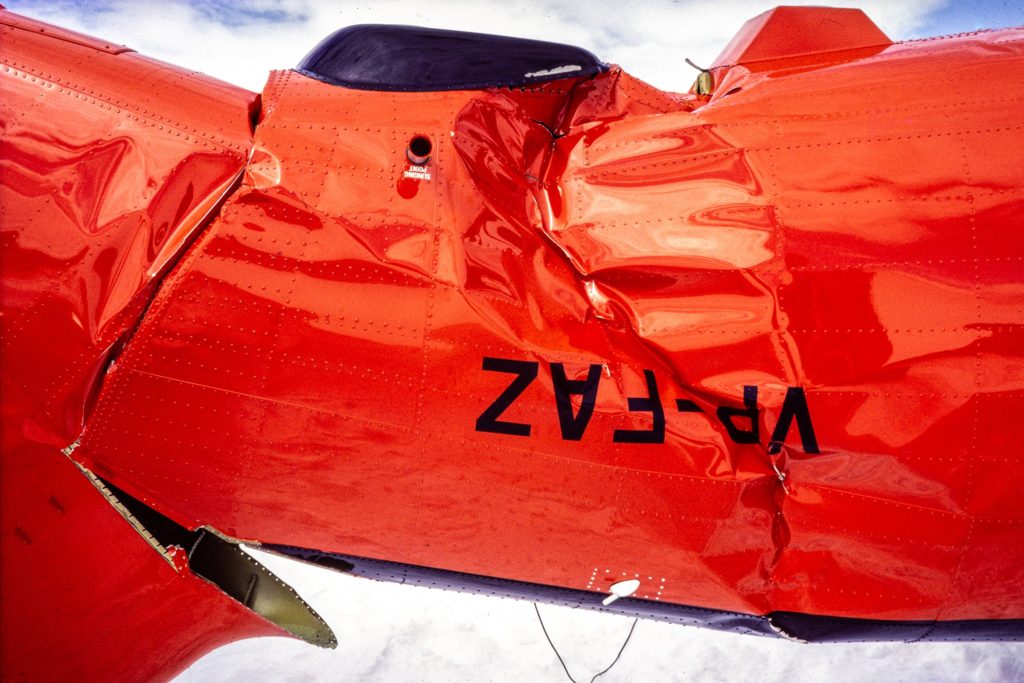
Shortly after arrival at Rothera from Damoy there was a night that would turn our season on its head, both literally and figuratively.
1982 – Winter
Base Commander – Alan McManus
| Finch, B.R. | Tractor Mechanic |
| Fraser, S.J.R. | GA |
| Green, M.W. | Medical Officer |
| Hogg, J.N. | Electrician |
| Lovegrove, I.W. | GA |
| McManus, A.J. | BC, Cook |
| Morton, A.C. | GA |
| Newstead, R.J. | Radio Operator |
| Phillips, R.S. | Builder |
| Tickle, A.N. | Tractor Mechanic |
| Wallis, D.J. | DM |
| Wilson, K.C. | Meteorologist |
| Young, N.St.J. | GA |
A Bump Start – Simon Fraser
Any dog driver knows that one of the critical moments in controlling his team is the start, particularly when leaving base. The team is at a high pitch of boundless excitement and enthusiasm and with perhaps 30 other dogs in the vicinity vigorously barking, the line between chaos and control is sometimes thin. ‘Doc’ Martin Green was about to leave Rothera Base with the Admirals and all was going well so far.
As was the custom, the back of the sledge was conveniently secured to a back picket by running the sledge’s trail rope around a metal stake in the ground at the end of the dog spans, and bringing it back to the sledge to hook the end loop over the handlebars. At the critical moment, unhooking this trail rope ensures a smooth and effortless departure.
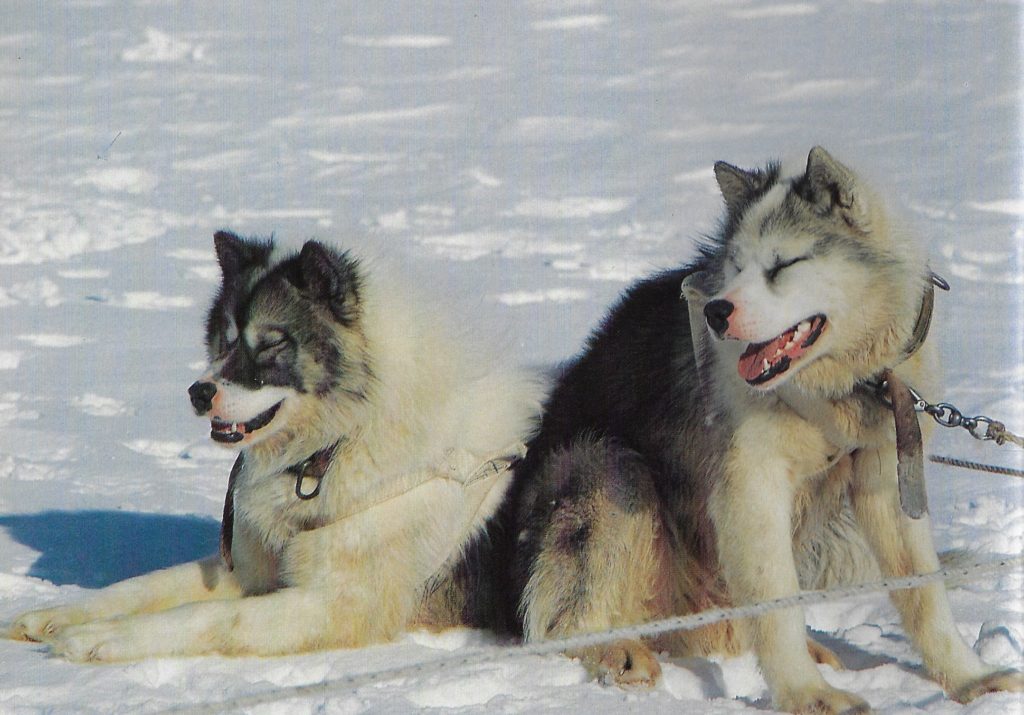
Martin lifted the loop off and the dogs accelerated rapidly towards the sea ice. A second later the sledge came to a total and abrupt halt: the ‘monkey’s fist’ knot at the end of the trail rope had somehow jammed itself around the metal stake. Martin was catapulted forward over the handlebars onto the sledge, landing in the snow in a sprawling heap, whilst nine powerful huskies were manically straining at the immobile sledge. Before Martin had time to realise what had happened, the ‘monkey’s fist’ came free and the sledge took off. Martin just managed to react fast enough to grab the trail rope with the monkey’s fist as it streaked past him. He was now being dragged headlong at high speed down a bumpy snow slope towards the sea ice with the team running flat out!
Meanwhile the ‘experts’ standing nearby or comfortably seated by the bar window looked on with vast amusement – and let it be said, admiration – as the doctor pulled himself hand over hand along the trail rope and regained the sledge, in a text book example of how to recover a runaway sledge team before it disappeared into Laubeuf Fjord!
Simon Fraser, Rothera, GA, 1982
Before and After the Falklands War – Steve Garrett
This entry is from my own memories and diaries combined with the accounts of my geophysical colleague Bruce Herrod. Digital image processing by Chris Bell.
Here are experiences and observations before and after the Falklands War, which was to have a profound effect on BAS operations in Marguerite Bay and beyond.
Before

On our way south for the first time in late October 1981, we arrived at Stanley Airport in a flight from Comodoro Rivadavia in Argentina. The customs officer quizzed us “What have you got in that bag? What drugs are you carrying? Not even BAS drugs? Bruce wrote: “We were the first BAS personnel to arrive since last season. It was a very warm and friendly welcome indeed.” I recall our hosts John Smith and family at Sparrowhawk House mentioning how the UK Government was withdrawing the patrol ship HMS Endurance the following summer season to save money.
Ronne Ice Shelf Oversnow Traverses – Steve Garrett
This photo essay is from the images of my geophysical colleague Bruce Herrod. We had been hired in 1981 by Geoff Renner to work on a regional glaciological and geophysical project surveying the Ronne Ice Shelf. This was a significant step-up in scale and ambition for BAS remote field work, setting the scene for the large, integrated remote projects (e.g. the Thwaites Glacier Project) that are a feature of BAS today. Bruce led two summer seasons of oversnow traverses – gravity and seismic sounding.
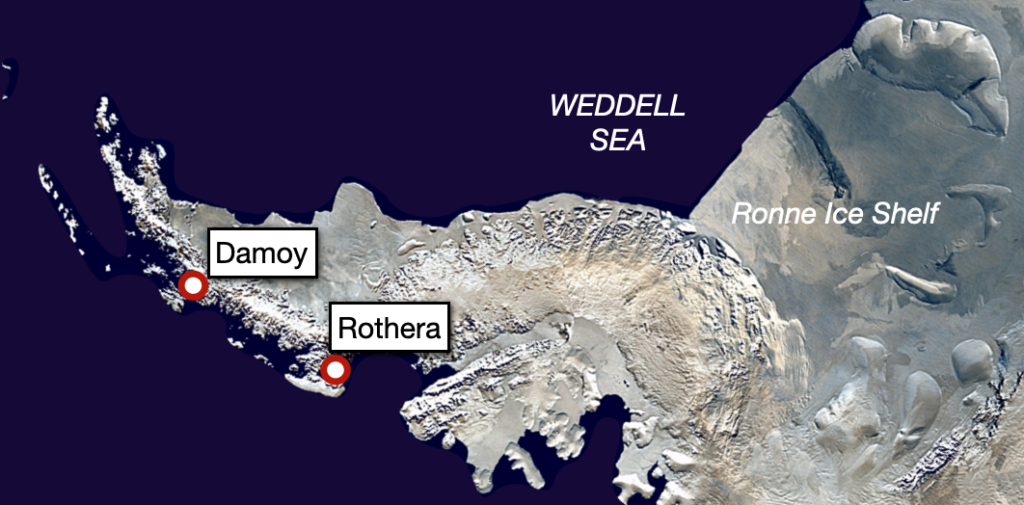
It would be fair to say that it took a while to get there. Our first attempt in 1981 was frustrated by the loss of both aircraft shortly after our arrival at Rothera (see “The Night the Planes Blew Over” in 1981) with additional drama provided by the Falklands War above. On returning to BAS HQ in Cambridge, the enforced delay allowed us the chance to upgrade our seismic recording equipment from analogue to digital. On our return in 1982, after a relatively smooth transit through Damoy in 1981, in one week in late November at Rothera we tested all the land seismic and gravity gear and accomplished more than we had in the preceding season. I recall the very interesting effects generated by letting off seismic charges under sea-ice in Marguerite Bay – echoes between the seabed and water surface like an explosion in a cathedral, while the sea ice rippled like the skin of a huge drum.
Airborne Adventures Across West Antarctica – Steve Garrett
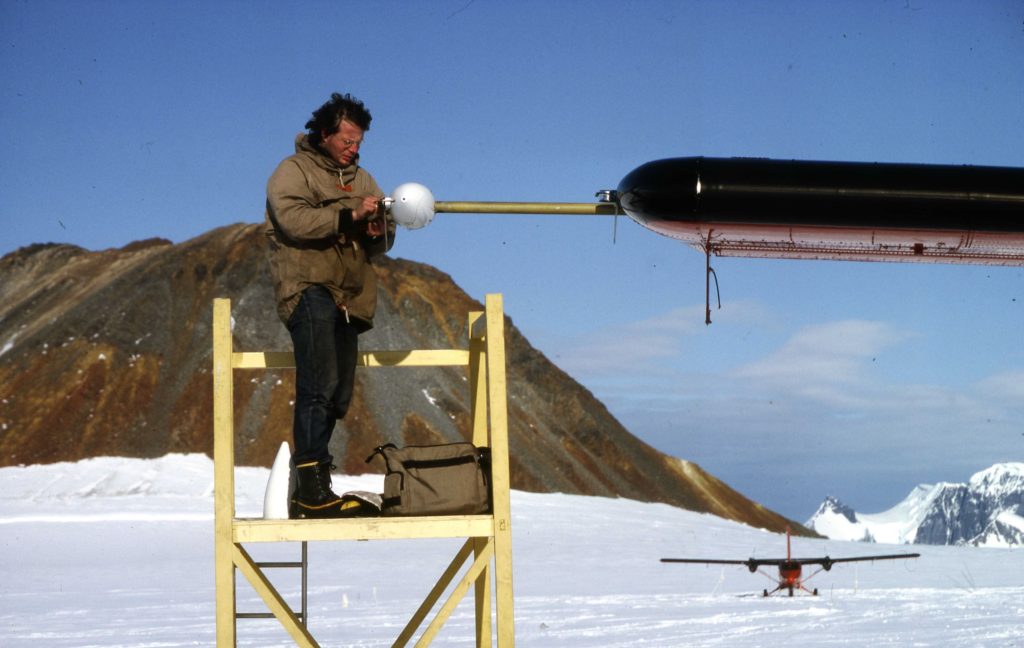
(Photo: Bruce Herrod)
I was fortunate to be involved in airborne geophysical fieldwork during summers from 1981 until 1984, when Rothera was largely a staging post for adventures further afield. While the first field season was terminated by The Night The Planes Blew Over (see 1981 above) followed by the drama and tragedy of the Falklands War (see above), we finally got to work in the austral summer of 1982 covering land, sea and ice shelf from the South Shetland Islands to the Thiel Mountains. This marked turning points in tying up the surveys of the Antarctic Peninsula, in regional cross-disciplinary multi-national projects for BAS, in the onset of extreme tourism, and in analogue-to-digital conversion.
1983 – Winter
| Bales, C.M. | Meteorologist |
| Bell, J.A. | Medical Officer |
| Cleary, P.J. | GA |
| Day, R.G. | Tractor Mechanic |
| Finch, B.R. | Tractor Mechanic |
| Foreman, P. | Cook |
| Lovegrove, I.W. | GA |
| McKee, R.J. | GA |
| Morton, A.C. | GA |
| Newstead, R.J. | Radio Operator |
| Phillips, R.S. | Builder |
| Wallis, D.J. | DM |
1984 – Winter
| Cain, A. | GA |
| Cleary, P.J. | GA |
| Day, R.G. | Tractor Mechanic |
| Foreman, P. | Cook |
| Henderson, A.S. | Medical Officer |
| Irons, R.K. | Builder |
| O’Donnell, M.J. | Radio Operator |
| Spearey, A.G. | Tractor Mechanic |
| Stark, P.R. | Meteorologist |
| Stewart, D. | GA |
| Summerson, R.M.V. | GA |
| Wood, P. | GA |
| Young, V.C. | Electrician |
The Seven Summits Team at Rothera Airstrip
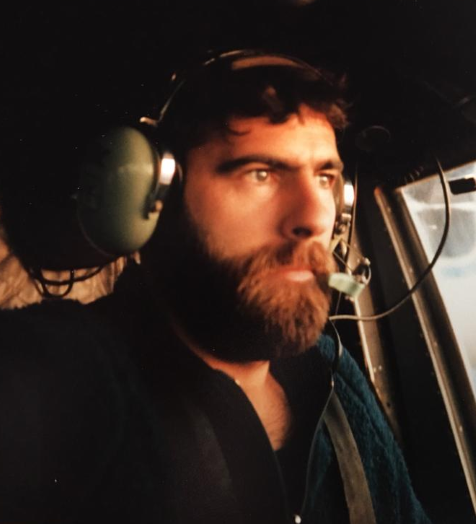
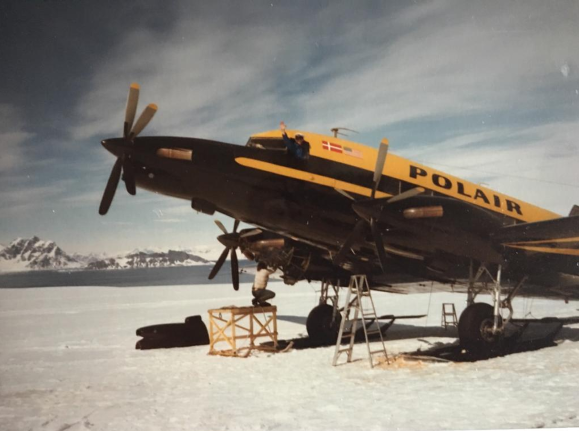
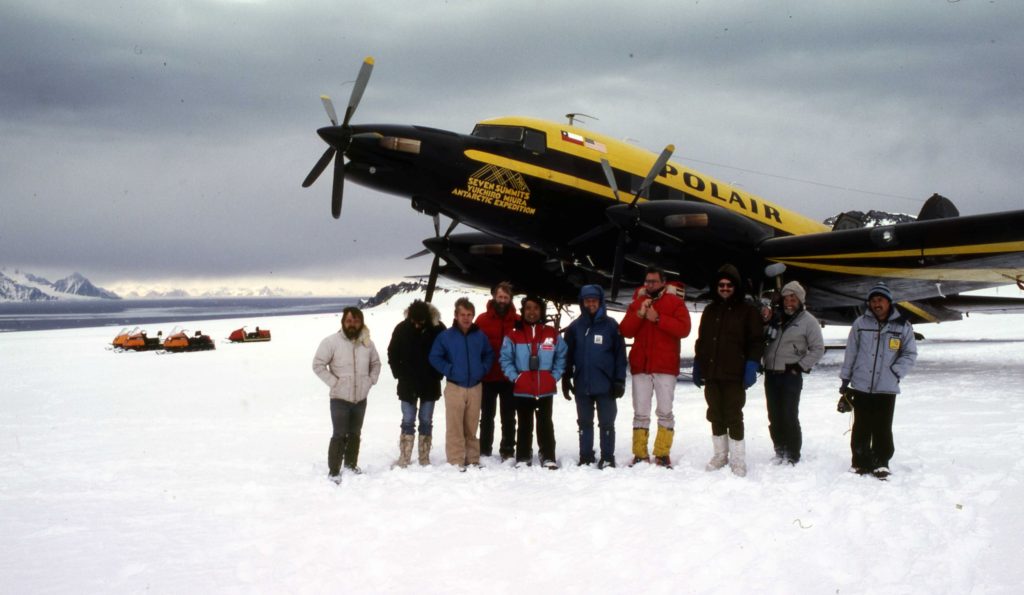
(Photo: Bruce Herrod)
1985 – Winter
| Bates, C.P. | DM |
| Collins, C.P. | Cook |
| Griffiths, C.J. | GA |
| Heyworth, S.J. | Tractor Mechanic |
| Irons, R.K. | Builder |
| Lawther, R.H. | Meteorologist, Physicist |
| O’Donnell, M.J. | Radio Operator |
| Roberts, J.G. | Medical Officer |
| Simpson, A.R. | GA |
| Spearey, A.G. | Tractor Mechanic |
| Stewart, D. | GA |
| Summerson, R.M.V. | GA |
| Wood, P. | GA |
| Young, V.C. | Electrician |
“Abandon Ship” – in the Antarctic – Jonathan Walton
I had been asked by BAS to be a surveyor/glacio/GA for the 1985/86 summer season, finishing off a massive glaciological programme on the Rutford Ice Stream at some 79deg South, next to the Ellsworth Mountains. I had worked there for the 1978/79 season and was keen to return – imagine stupendous scenery, a wide open glacier and never ending good weather – so different from much of my earlier BAS experiences further North.
But first I had to get to Rothera to start the long series of flights to get me to the Rutford.
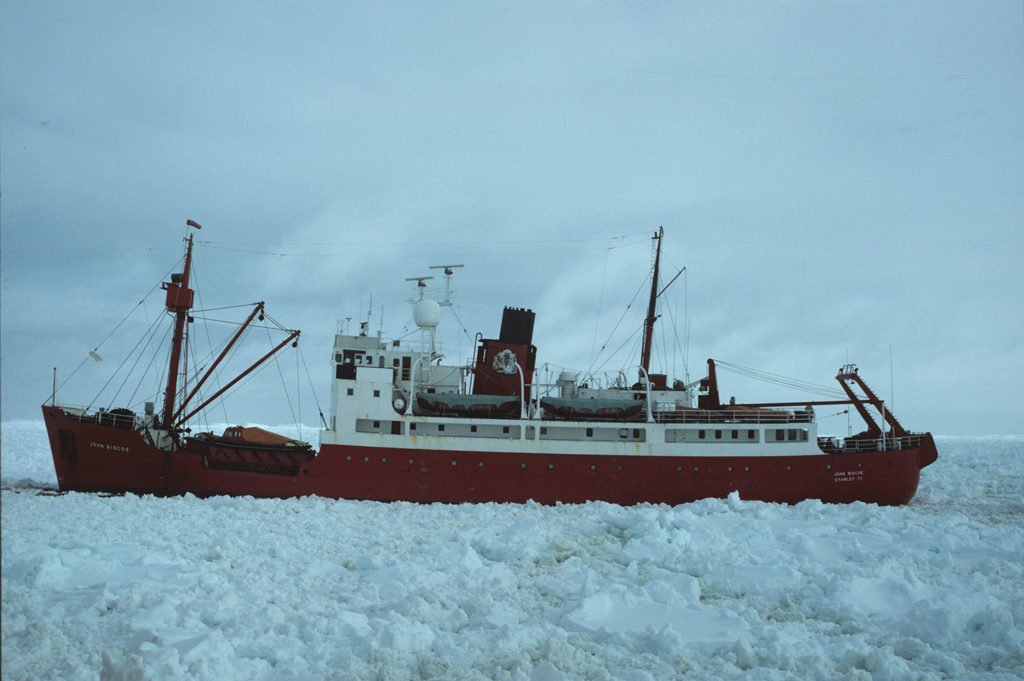
Sunday morning, 10th November 1985. The John Biscoe is heading South, not far off the coast of Adelaide Island, just coming into Marguerite Bay. Open water, blue skies and a light wind. Rothera is also reporting no sea-ice present so we start thinking that we might be there in 12 hours or so without having to do the Damoy shuttle which would make a brilliant start to what was likely to be a full season.
But then, on the horizon a white strip appears. Sea-ice. One of the Twin Otters flies overhead and reports that the band of ice is about 15 miles wide, relatively loose brash and after that it is clear water all the way. Excitement mounts as the ship puts her nose into the ice and makes good progress. But then, within the next hour or so and with little warning, the wind changes direction and the brash ice, instead of being loose, becomes 4ft thick gooey porridge.
1986 –
1987 – Winter
| Abbey, W. | Builder |
| Armstrong, N.F. | GA |
| Bennett, N. | DM |
| Bithell, M.R. | Builder |
| Burns, S. | Tractor Mechanic |
| Carroll, D.J. | GA |
| Casson, R.M. | Builder |
| Dark, W.K. | GA |
| Day, C.M.J. | GA |
| Donnelly, P.E. | Electrician |
| Dove, S.B. | Builder |
| Figg, D.W. | Builder |
| Gill, S.N. | Builder |
| Goosey, S.D. | Cook |
| Hormbrey, P.J. | Medical Officer |
| Jobes, D.R. | Electrician |
| Lenartowicz, J.N. | Radio Operator |
| Maile, G. | Builder |
| Marquis, P.T. | GA |
| Milner, C.J. | Tractor Mechanic |
| Powell, M.D. | Builder |
| Probert, D. | Builder |
| Row, M.G. | Meteorologist |
| Smart, I.J. | Builder |
| Stott, A.J. | Plumber |
| Taylor, M. | Plumber |
1988 – Winter
| Abbey, W. | Builder |
| Armstrong, N.F. | GA |
| Bennett, N. | DM |
| Bithell, M.R. | Builder |
| Burns, S. | Tractor Mechanic |
| Carroll, D.J. | GA |
| Casson, R.M. | Builder |
| Dark, W.K. | GA |
| Day, C.M.J. | GA |
| Donnelly, P.E. | Electrician |
| Dove, S.B. | Builder |
| Figg, D.W. | Builder |
| Gill, S.N. | Builder |
| Goosey, S.D. | Cook |
| Hormbrey, P.J. | Medical Officer |
| Jobes, D.R. | Electrician |
| Lenartowicz, J.N. | Radio Operator |
| Maile, G. | Builder |
| Marquis, P.T. | GA |
| Milner, C.J. | Tractor Mechanic |
| Powell, M.D. | Builder |
| Probert, D. | Builder |
| Row, M.G. | Meteorologist |
| Smart, I.J. | Builder |
| Stott, A.J. | Plumber |
| Taylor, M. | Plumber |
Final Breeding – Simon Gill
I have no real epic journeys to speak of. Just the sheer compassion I have in being very fortunate in having run the dogs in such a unique and wonderful wilderness. The dogs provided a great release during a very hectic winter when Rothera Station went through its rebuild stage.
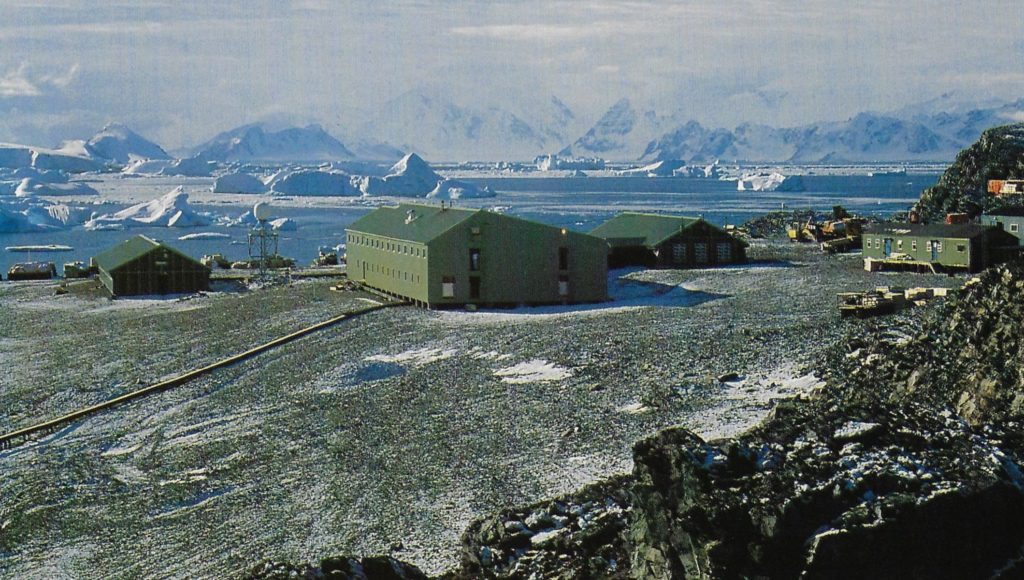
During that winter we were fortunate in being able to breed from the final stock and exchange some new and desperately needed blood from the San Martin base (Argentinian) near to Stonington.
We exchanged two of our excellent working dogs, Elly and Vega. Vega himself was a Kiwi dog given to us previously from the Scott Base. The exchange was made possible by having an excellent sea-ice winter which enabled extensive travel to the mainland and as far South to visit San Martin and Stonington. In return we received two Argentine dogs – Jimmy and Urza. Urza was a very scatty and hyperactive male. At 18 months old his only desire was to fight with any dog, be it big or small, that should cross his path. Not only did he always lose and seem to come off worse for wear, he never learnt, and continued to take a lifetime of beatings. Jimmy was very much the opposite and looked very solemn and sultry from day one.
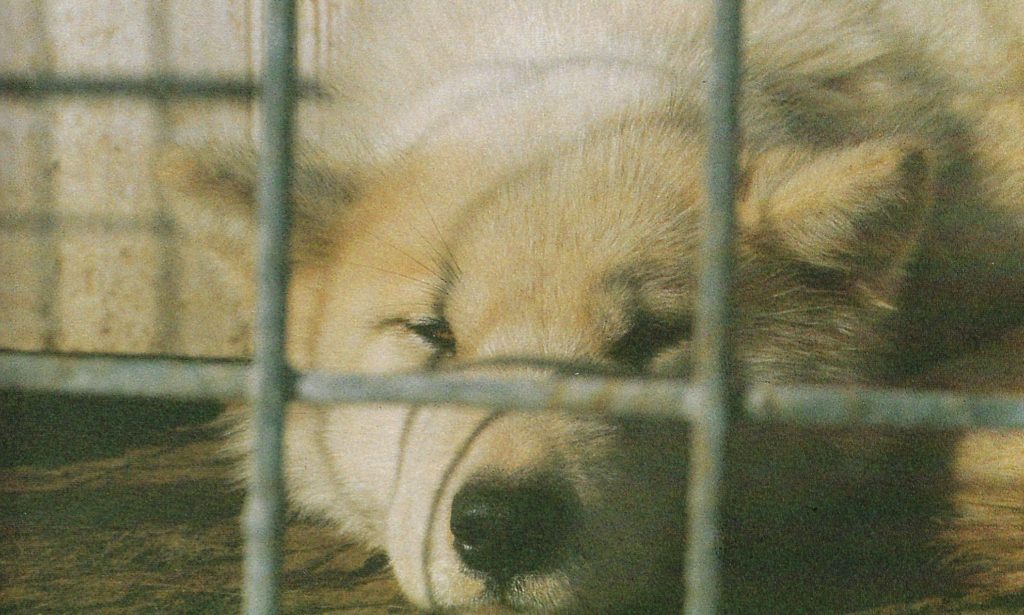
It seemed as though we had lost out significantly in this exchange until unbeknown to us Jimmy after only 10 days on base gave birth to two fine young bitches, Nuk and Pujok. They grew up together on the spans and ran as one of the strongest and most faithful partnerships in the Huns team. Seldom did they fight together, a unique occurrence as a female pair only wanting to fulfill a Huskies true role, to pull in their harnesses. Not only did Jimmy produce a fine working pair, but at the same time as she was weaning Nuk and Pujok, a second mum Gretel gave birth to three pups, Arthur, Morgan and Martin. Unfortunately Gretel was not of the maternal kind and rejected her newborn offspring. We had suspected this from Gretel, hardly the Lady of the pack, and our only option was Jimmy. Jimmy proved to be a fine mum and adopted the three pups immediately as her own. It was with great success that Arthur and Morgan grew into strong and healthy dogs along with their adopted sisters Nuk and PujoL Jimmy continued to run as a fine sledge dog and is now the grand mother to Pujok’s offspring, Tom, Biff and Wendy.
Simon Gill – Rothera, Builder, 1987 & 1988
1989 – Winter
| Burgess, G.N. | Tractor Mechanic |
| Collins, C.P. | Base Assistant |
| French, T.G. | Electrician |
| Hignell, M. | Field Assistant |
| Leader, M.J. | Cook |
| Love, I.S. | Builder |
| MacConnachie, A. | Field Assistant |
| Makkison, I. | Medical Officer |
| Morton, A.C. | Field Assistant |
| Nixon, L.D. | DM |
| Osborne, A.C. | Meteorologist |
| Silvester, A.J. | Plumber |
| Speakman, J.H. | Radio Operator |
| White, D.J.E. | Tractor Mechanic |
| Whitford, M.D. | Field Assistant |
1990 – Winter
| Blissett, J.M. | Plumber |
| Blunn, J.W. | Field Assistant |
| Butler, M. | Cook |
| Carroll, D.J. | Field Assistant |
| Dark, W.K. | Field Assistant |
| Hignell, M. | Field Assistant |
| Lacey, A.J. | Meteorologist |
| Love, I.S. | Builder |
| Ludington, M. | Medical Officer |
| Lush, C.P. | Radio Operator |
| McManus, S.J. | Medical Officer |
| Nixon, L.D. | DM |
| White, D.J.E. | Tractor Mechanic |
| Wilson, D.M. | Tractor Mechanic |
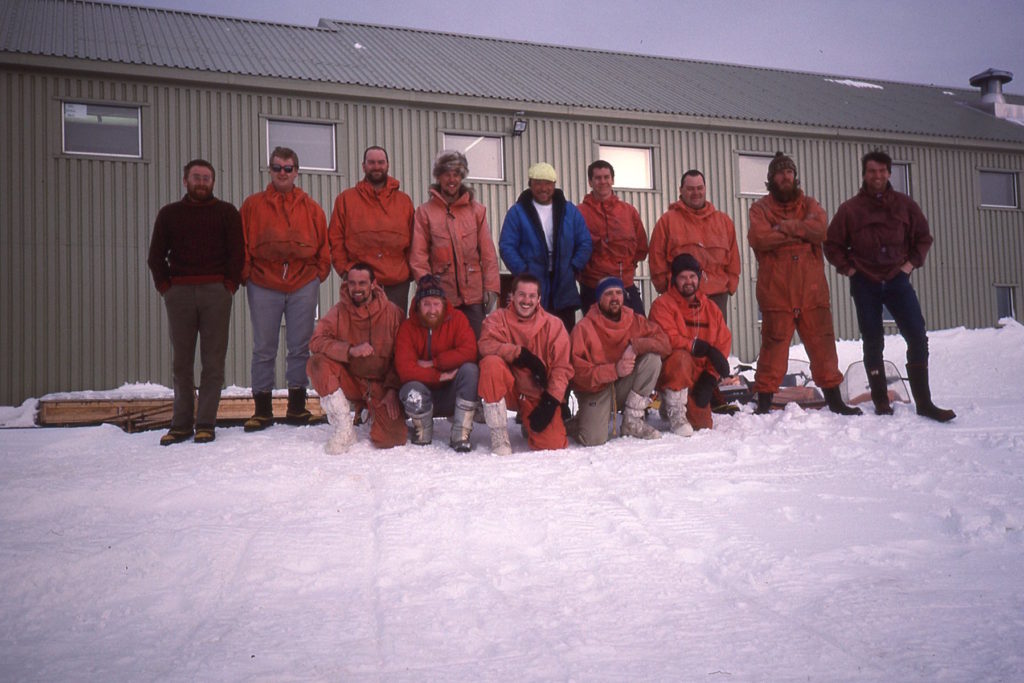
Bottom L-R Ian Love, Damo Carrol, Steve McManus, Dave Wilson, Mike Butler. (Photo: John Blunn)
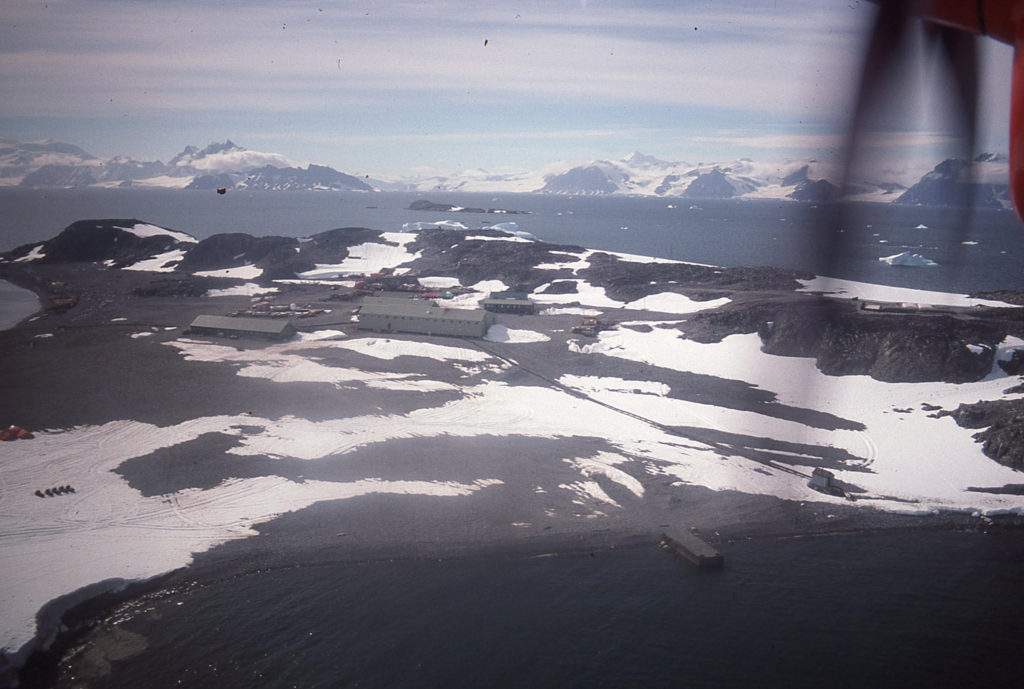
1991 – Winter
| Bamber, J.H. | Medical Officer |
| Blunn, J.W. | Field Assistant |
| Butler, M. | Cook |
| Crawford, B.R. | Field Assistant |
| Davies, S.R. | Field Assistant |
| Lacey, A.J. | Meteorologist |
| Lindsay, M.R. | Tractor Mechanic |
| Lush, C.P. | Radio Operator |
| McManus, S.J. | Medical Officer |
| Powell, M.D. | Builder |
| Routledge, D.C. | Field Assistant |
| Scott, R.K. | Plumber |
| Taylor, A.J. | Field Assistant |
| Wilson, D.M. | Tractor Mechanic |

The last of the dog teams, and work on the new wharf and runway, here
1992 – Winter
| Bird, T.J. | Field Assistant |
| Burgess, G.N. | Tractor Mechanic |
| Cummins, S.P. | Meteorologist |
| Dean, N.B. | DM |
| Dow, S.T. | Plumber |
| Hobson, R.P. | Medical Officer |
| Hopkins, S.D. | Tractor Mechanic |
| Hull, B.J. | Field Assistant |
| McCaffery, S. | Communications Manager |
| Powell, M.D. | Builder |
| Routledge, D.C. | Field Assistant |
| Sweeny, J.P.A. | Field Assistant |
| Taylor, A.J. | Field Assistant |
| Whetton, A. | Cook |
| Whiting, C.R. | Electrician |
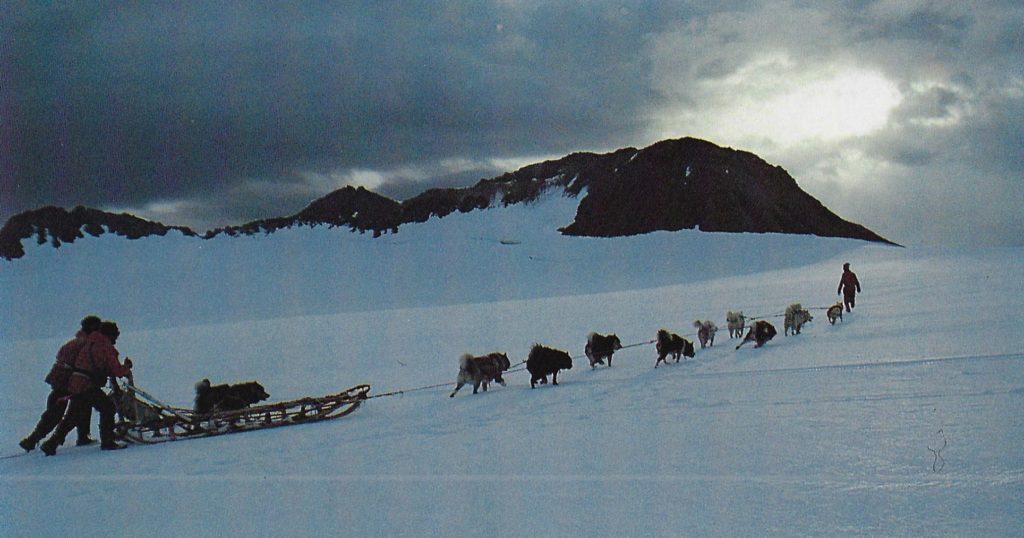
1993 – Winter
| Cummins, S.P. | Meteorologist |
| Dean, N.B. | DM |
| Dow, S.T. | Plumber |
| Farkas, K.F. | Field Assistant |
| Hopkins, S.D. | Tractor Mechanic |
| Hull, B.J. | Field Assistant |
| McCaffery, S. | Communications Manager |
| McGlone, R. | Builder |
| Rumble, S. | Electrician |
| Siderfin, C.D. | Medical Officer |
| Smith, Alan A. | Field Assistant |
| Smith, Allan | Tractor Mechanic |
| Sweeny, J.P.A. | Field Assistant |
| Whetton, A. | Cook |
| Wilson, B.J. | GA |
Disturbed Nights with the Children – Charlie Siderfin
April 14 Suddenly, above the noise of the blizzard we heard the wind banging on the nutty box. I peeked out into the night and there was Fido. He had a huge smile on his snow covered face, his tail swinging back and forth jack-knifed his whole body, his tongue protruding slightly from the foxy smile. I can’t describe how delighted he was to see me. As I got dressed and pulled on my boots his head kept popping through the doorway to check that I was still there, he seemed to be telling me to hurry up. I think he was quite surprised at the splendour and comfort of our tent. If the other dogs hear of this, we may well have a mutiny.
…Fido got off a second time, his clip must be very loose. However, he’s no problem at all, he comes trotting straight back to the span as soon as he is called.
April 19 Lie up day number five! When I got up this morning, the wind had settled a bit but there was still heavy snow falling. We had had a disturbed night. About 2.00am Fido slipped out of his collar and went on the rampage for Nutty at the depot, stumbling over Al and Stu’s guy ropes en route. Al got the fright of his life when he looked out to see what was going on. All he could see was a pair of green eyes coming for him. The other dogs were making a racket, rushing around in circles on their span trying to get to Fido. Hurriedly dressing, I got out at the same time as Al and we put Fido back on the span.
April 20 Again at 7.30 there was a commotion. It was Blackie this time who was off. The other dogs were going mad. I was afraid they would pull out the deadmen that anchored the span; then there would be fun. There was no time to lose. Pulling on my mukluks, I half streaked out of the tent in my thermals, cursing at the cold, the dogs and having to leave my warm sleeping bag behind. Blackie was hanging around Biff and Tom, staying just out of reach to tantalise them. I could see their flashing green eyes reflected in the head torch as all nine dogs strained to get to Blackie, barking and rushing around in frustrated circles. Surely the trace would come loose. Screaming at Tom and Biff, I grabbed Blackie and clipped him back onto his span. The tips of his black fur glistened white with rime ice.
The dogs calmed down, disaster had been averted. Sticking my cold, aching hands between my thighs I ran, half crouching, back to the tent. Although the tilly had been put out hours ago, it felt warm inside. I crawled back into my sleeping bag. Children! Who would have them?
Charlie Siderfin, Medical Officer
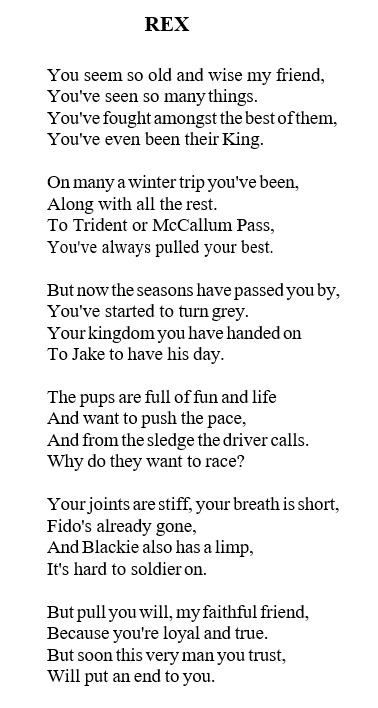
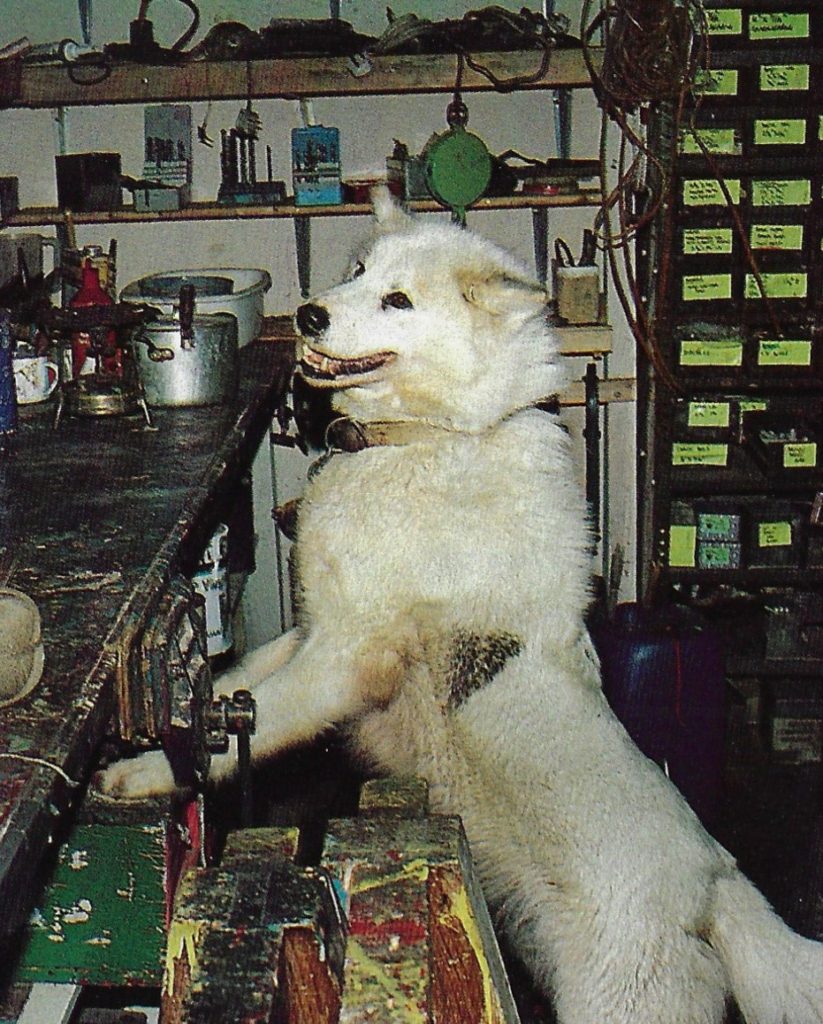
(Photo: Brain Hull)
The Last Antarctic Amateur Vet – Charlie Siderfin
During the winter of ’93 the majority of the dogs were getting on. True, we had the five “Pups” who were two years old, but the rest were all over six and some of the dogs were nine. As a result we seemed to get more than our fair share of dog illness.
The week before leaving the UK, I paid a flying visit to Bob Bostlemann (Stonington Vet 72-74) en route from Aberdeen to London, having just completed three months training with the BAS medical Unit. Bob had kindly offered me the opportunity to spend a few days with him to learn some tricks of the trade, but time only permitted an afternoon. As it was I was late and my veterinary training was limited to an overweight poodle and two cats.
Video by Rob McGlone, Base Carpenter
1994 – Winter
Base Commander – Steve Rumble
| Bailey, D.R. (Dave) | Cook |
| Bell, M.H. (Martin) | Tractor Mechanic |
| Davison, P.S.G. (Paul) | Meteorologist |
| Elvin, T.J. (Tim) | Field Assistant |
| Farmer, P. | Field Assistant |
| Gemmell, I.M.M. | Medical Officer |
| Holborn, P.E. | Field Assistant |
| Jones, M.K. | Tractor Mechanic |
| Kirby, N. | Plumber |
| McGlone, R. | Builder |
| Roberts, T.W. | DM |
| Rumble, S. (Steve) | BC/Electrician |
| Smith, Alan A. | Field Assistant |
| Taylor, G.A. | Communications Manager |
| Thompson, P.A. | Field Assistant |
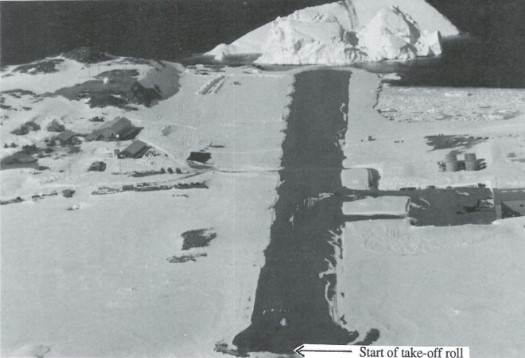
Although not directly related to FIDS, an aircraft accident happened at Rothera during the winter (courtesy of Rob Campbell, Air Mech, Adelaide 71/72) – Read on
1995 – 1996 – 1997 – 1998 –
1999
| Annat, M.M. | Field Assistant |
| Baker, J.G. | Cook |
| Barnes, C. | Diver |
| Beaumont, J.C. | Assistant Marine Biologist |
| Blenkharn, N. | DM |
| Conn, N.M.M. | Field Assistant |
| Day, C.M.J. | Field Assistant |
| Fell, G.R. | Meteorologist, Physicist |
| Fraser, K.P.P. | Marine Biologist |
| Geissler, P.A. | Terrestrial Field Assistant |
| Grey, P.G. | DM |
| Hinde, S.V. | Field Assistant |
| Hughes, K.A. | Microbial Eco-Physiologist |
| Jeffery, G. | Electrican |
| Jeffrey, M. | Meteorologist, Physicist |
| Jobson, M.R. | Builder, Carpenter |
| Martin, P.D. | Electrician |
| McDonald, I.D. | Boatman |
| Parsons, I.R. | Communications Manager |
| Thompson, C. | Tractor Mechanic |
| Thomson, L.F. | Medical Officer |
| Wickens, P.J. | Field Assistant |
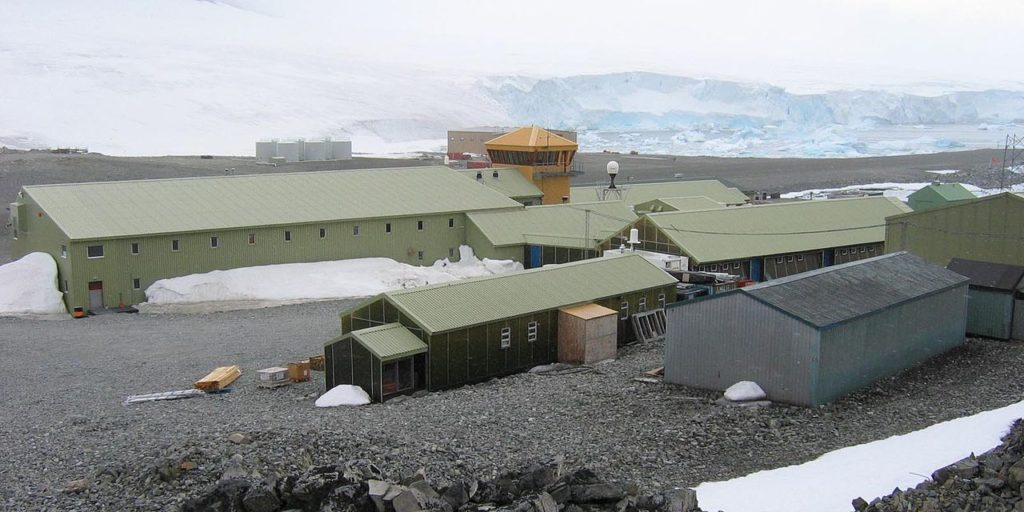
2000
| Ainscough, S.R. | Plumber |
| Beaumont, J.C. | Assistant Marine Biologist |
| Brown, H.C. | Diver |
| Burrows, C.J. | Medical Officer |
| Conn, N.M.M. | Field Assistant |
| Fell, G.R. | Meteorologist, Physicist |
| Fraser, K.P.P. | Marine Biologist |
| Geissler, P.A. | Terrestrial Field Assistant |
| Goodhand, R. | Meteorologist, Physicist |
| Grey, P.G. | DM |
| Hinde, S.V. | Field Assistant |
| Martin, P.D. | Electrician |
| Milner, P.J. | Field Assistant |
| Owen, H.P. | Boatman |
| Parsons, I.R. | Communications Manager |
| Pledger, S. | Builder, Carpenter |
| Reynolds, D.W. | Field Assistant |
| Thompson, C. | Tractor Mechanic |
| Turner, I.C. | Tractor Mechanic |
| Walker, K.A. | Cook |
2001
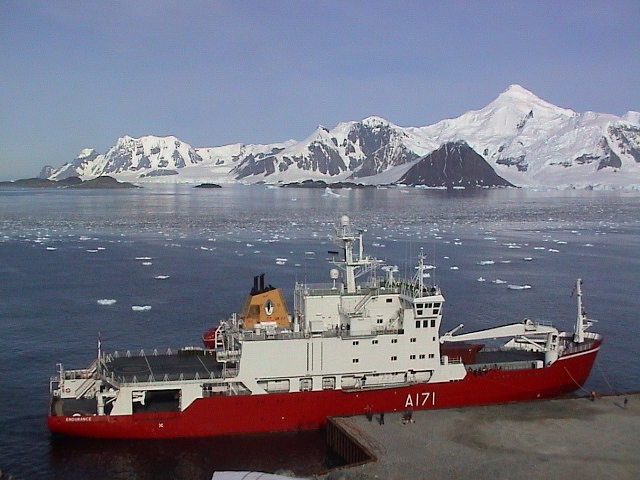
| Aston, F.A.D. | Meteorologist, Physicist |
| Bowden, D.A. | Marine Biologist |
| Chapman, A.S. | Field Assistant |
| Corbett, T.W. | Mobile Plant Technician |
| Cryer, P.K. | Plumber |
| Dean, J.M. | Medical Officer |
| Ellis, D.T. | Base Assistant |
| Gilchrist, W.P.G. | Boatman |
| Hall, C. | Electrician |
| Horne, P.A. | Diver |
| Le Bretton, S.P. | Mobile Plant Technician |
| Leach, J.M. | Fixed Plant Technician |
| Martin, I.P.S. | Meteorologist, Physicist |
| Milner, P.J. | Field Assistant |
| Molyneaux, D. | Communications Manager |
| Nicholson, M.J. | Terrestrial Research Assistant |
| Piper, R. | Assistant Marine Biologist |
| Powell, M.D. | Builder |
| Routledge, D.C. | Field Assistant |
| Taylor, A.J. | Field Assistant |
| Walker, K.A. | Cook |
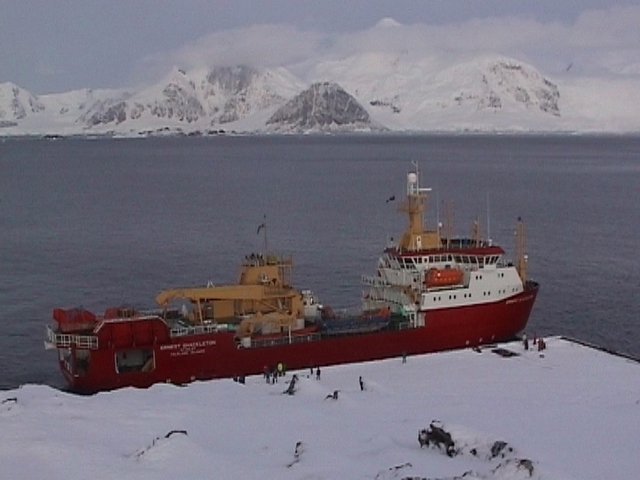
(Photo: Jenny Dean)
Jenny Dean’s Diary
April
April was our first full winter month with more of an Antarctic community in the winter. We’ve been in touch with various other bases. Every Monday night we have a radio conversation with St. Martìn, the Argentinean base nearest to us. The great Antarctic tradition of radio darts has also continued and we have so far had a match each with the British bases, Bird Island and Halley, both of which we won the beer round, although I don’t think Halley believed our luck, since we won 1001 (extended 301) with a three-dart finish. They will just have to take our word for it!
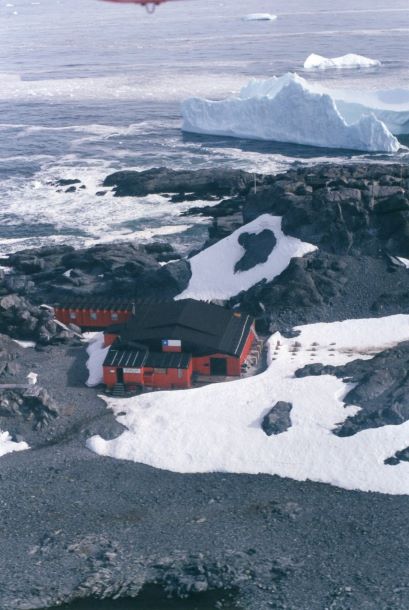
On the 6th April, I set off on a 6-day trip to the Chilean summer base, Carvajal, which is situated on the southern tip of Adelaide Island. Carvajal is the old British Adelaide base that existed before Rothera was built in the 70’s. It was a fascinating place, but without any heating or electricity, it was colder than being in a tent. At least you could get out and about even in the bad weather that we later experienced. The sea is a lot livelier there than Rothera and the place was teeming with fur seals, snow petrels, southern giant petrels and the usual skuas and kelp gulls.
Back at Rothera, the fur seals are still littering the place and our highest count on the point so far is 443 which is just 2 short of the record set in 1999. The snow petrels have started arriving here too and we’ve had more frequent sightings of southern giant petrels. Another favourite of mine is the cape pigeon (or pintado petrel) with its black and white speckled wings. The adelie penguins have been able to have a good feed after their moulting, by the looks of their bellies, and I finally saw a chinstrap penguin on one of our more beautiful days. To complete the range of penguins, we have also had an emperor penguin that has remained around our base for the past week already, and whom we’ve named Billy (as in –no-mates). He has been roaming around looking very despondent and sorry for himself. However, the best wildlife we’ve had this month has to be the whales. We have had regular sightings of minkes and humpbacks.
After Easter, two Canadian Kenn Borek Twin Otters arrived to undertake a historic medical evacuation at the South Pole. We had prepared the runway for use, clearing the snow (and fur seals!), and removing the drums off the runway lights (having only just put extra rocks on them all to prevent the wind blowing them away!). The hangar had to be cleared of all the vehicles that we store in there in the winter as well as our badminton court. It was great to see aeroplanes again, particularly since they brought with them bags full of fresh salad and pineapple. It was a Saturday night too, so we ate like kings (I later learned that apparently these were for the South Pole, but the
crew had made the mistake of storing them in our kitchen!). One Twin Otter flew to the Pole on Tuesday the 24 th whilst the second one stayed here as a backup. The historic 10-hour flight went smoothly and they landed at the Pole in the dark at a temperature of –67°C. After about a day’s rest they returned to us arriving at about 21:45 in the dark, with our runway lit up in all its glory. It’s always light in the summer when the planes are flying, so this was quite unusual for us. After an overnight rest, they left and it was all over, leaving us once more to settle into our winter routine alone.
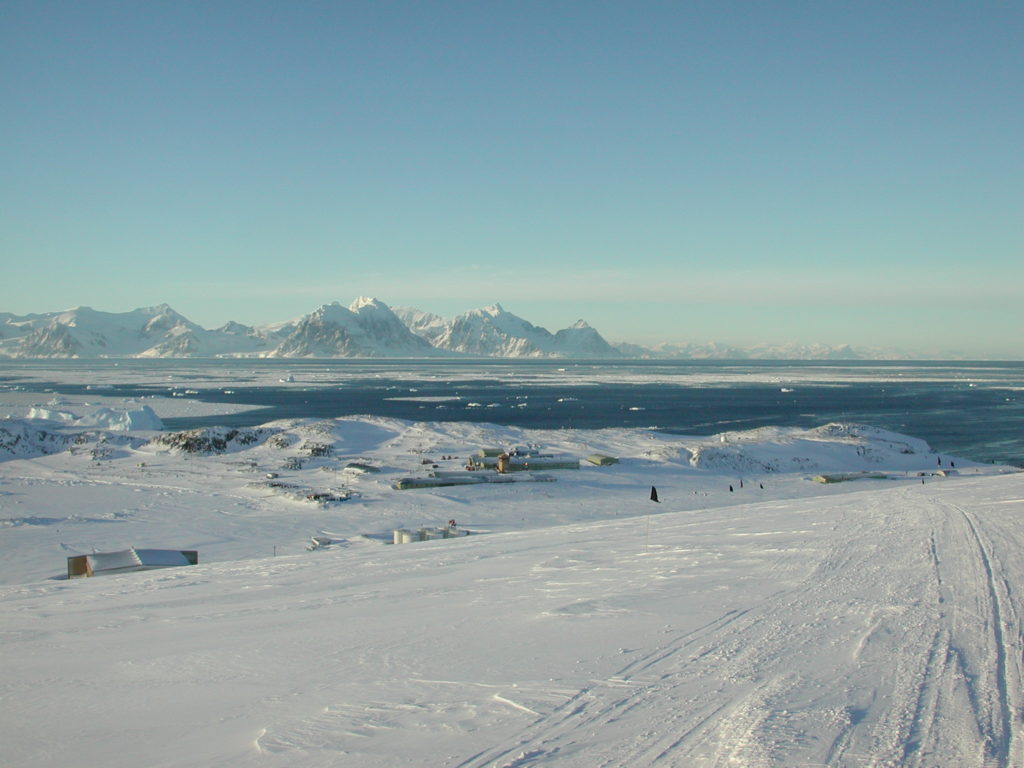
June
June’s highlight was Midwinter’s Day. We wished the other British Bases a Happy Midwinter and received a string of faxes and e-mails of good wishes from many people associated with and interested in our work here, including other countries’ leaders such as the Prime Minister of India and even George W. Bush! These were all printed out and pasted on the dining room walls amongst the Christmas decorations. At midday we gathered up at the memorial cross on the point for a group photo to commemorate the day before spending the rest of the morning getting ready in our best outfits. Drinks with ‘the magistrate’ were held in the bar at 1:30 before going through to the brilliantly decorated dining room. Keith, our chef had prepared for us a fantastic feast of 9 courses, which lasted until sometime around 6 pm. Settled in comfortably in the bar again, we listened to the BBC World Service broadcast that conveyed messages from our friends and families before the distribution of presents and general festivity for the remainder of the night.
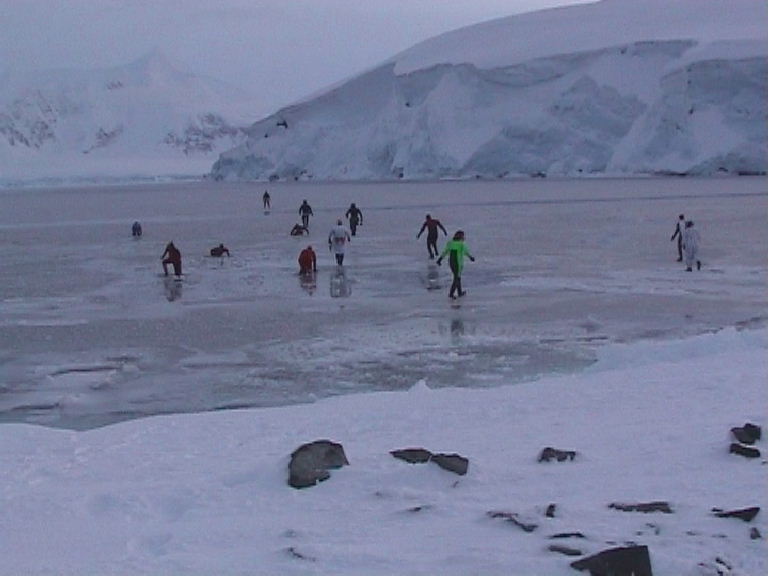
July
A week into July, we held what is traditionally known as the ‘Thin Ice Race’. This was first started thirty years ago at Signy Base (which is now a summer only base) on the South Orkney Islands. It involves donning a dry suit covered with fancy dress and running a race on the ice that had been assessed beforehand as being of the right thickness. Enough strength is required to hold a person’s weight, but at the same time it shouldn’t be too easy. It is expected that people fall through a few times at least.
See the YouTube video here:
Not everyone took part of course, as a few people opted to be ‘on standby’ with throw-ropes on the shore, as well being appointed as photographers. Not only was the whole experience fantastic fun, but it also taught us a lot about and develop great respect for the sea ice. If it’s not as easy as imagined extracting yourself when you’re in a dry suit, it would be a great deal worse with normal outdoor clothing. As far as the race was concerned, I gave up the lead long before the race even began and just enjoyed the strange sensations of bobbing about in the water surrounded by ice. I have great sympathy for seals getting out on the ice, as I tried to haul myself out on my belly without anything to grip on. Being –17°C that day, our fancy-dress clothing had actually frozen solid by the time we were back at the dive store in the Bonner Lab.
August
On the first weekend of August, we received a visit from the American research supply vessel, the Lawrence M. Gould. It was quite an occasion to suddenly triple the base complement for a few hours. It felt like the place was positively humming! One of the greatest treats for us was the exchange of some of our chocolate for a lot of their fresh produce such as salad, potatoes, avocadoes, mangoes, kiwi and other fruit. We were in heaven!
September
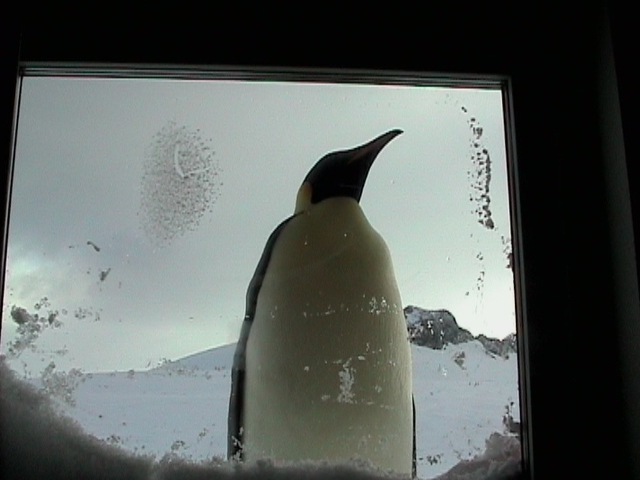
The sea ice has remained away for the entire month, with varying degrees of brash and pancake ice our only reminder of the fun we had when it was around. This has meant that the Adelie penguins have returned a lot earlier than usual and our first group, since the 4th July, were seen on the 16th.
We have also been thrilled to see the return of Billy the Emperor penguin. We are sure it’s the same penguin, because he is so inquisitive of the base and just strolls around everywhere exploring the buildings. Looking at the sonogram of his call, it is identical to the Billy we know of April / May time, yet different from another emperor that was around earlier this month. This latter penguin had no interest whatsoever in the activities on base and stayed near the shoreline. Billy had a particular interest in our buildings! He could get himself almost onto the roof of the Admirals House (the new accommodation block) thanks to the large snowdrift leading up to it. The windows were also accessible this time due to the snow and now he was able to see his reflection, which provided both him and us with hours of entertainment.
Other new sightings around the point are the Antarctic fulmars from the 21 st and the Antarctic terns. The latter are particularly welcome for their tweeting bird sounds. Most birds around here are silent, so it is a great pleasure to hear wildlife sounds around the point now.
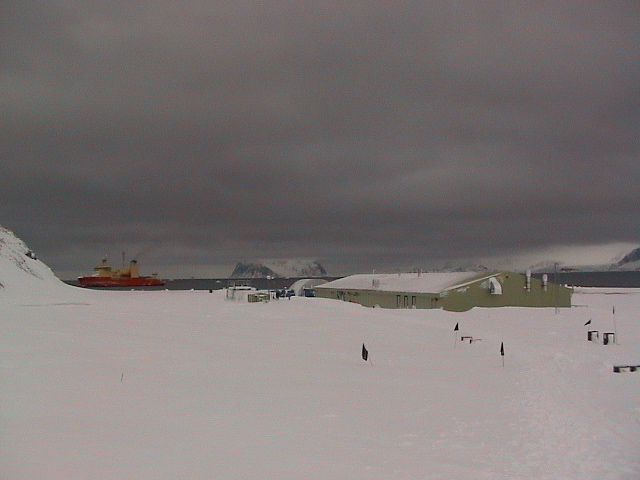
On the 22nd , we received our fourth group of visitors of the winter – a record for Rothera, I’m sure. This time it was the American research icebreaker, the Nathaniel B. Palmer. So, the shop was once more open for business and a gathering held in the bar. We were pleasantly surprised to see that quite a few of the people we have come to know from the visits of the Laurence M. Gould, were now on board the Palmer and our friendships renewed. We look forward to seeing them again next January too.
This month seemed to be full of disasters. Naturally it was a great shock for us to hear about the events in the States at the beginning of the month [9/11 – Twin Towers]. We do not have any access to television or the Internet, so all the news we got was from e-mails and some pictures sent to the base. So, all we could do was try and imagine what it must be like back home at the moment.
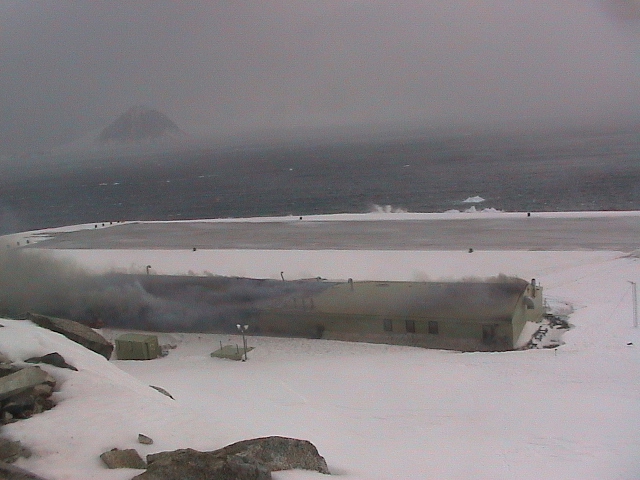
Our own disaster occurred on the night of Thursday the 27th. We were woken by the fire alarm after half past midnight, to find that this time it was for real as a fire had been seen in the loft of the Bonner Laboratory. Any attempts to put the fire out were sadly in vain, and the rest of us could only stand by and watch as the building burnt down to the ground over the following 12 or so hours.
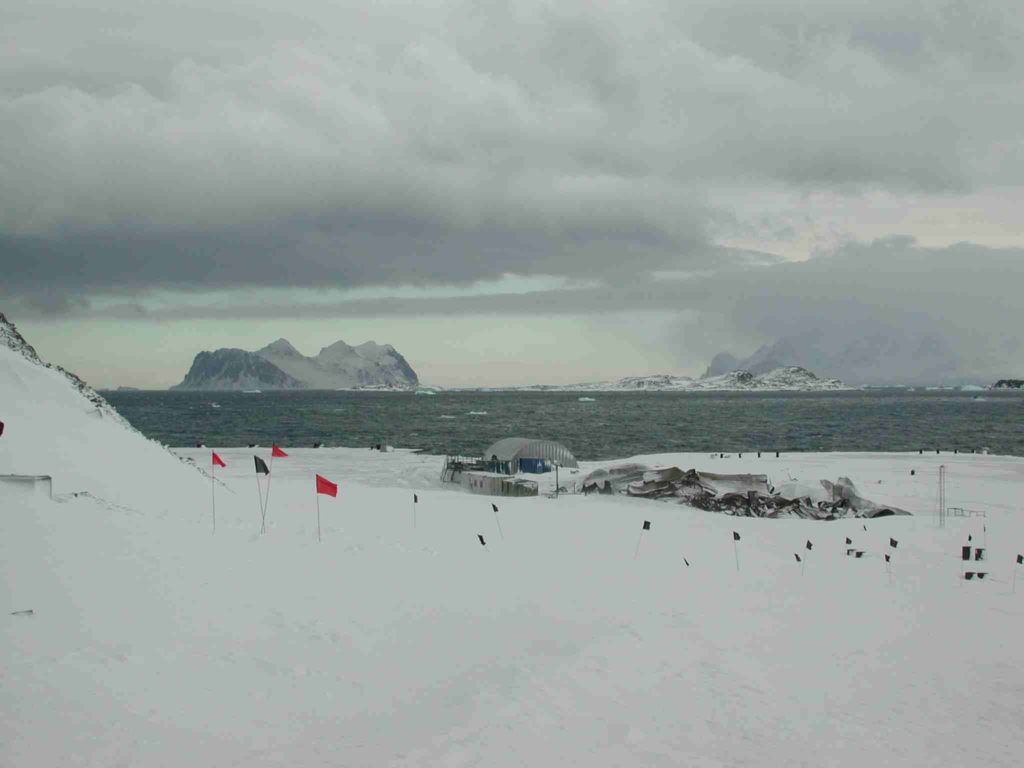
Although it hasn’t been very cold lately (mostly around freezing), we happened to have the strongest winds all winter at the time of the fire. The mean was about 63 knots at it’s worst with the highest gust being 83 knots. As the doctor, my main relief was that no one was hurt in any way.
To end on a good note, however, we were still able to get the boats out on the Sunday when the winds had died down and the sun shone through. Eight of us headed off to the nearby islands, Leonie and Lagoon, where we were thrilled to find that the Weddell seals had started giving birth in the past few days and we counted a total of 35 pups. They really are the sweetest little things. We were losing hope in seeing any around Rothera since they give birth on sea ice, so it was an extra bonus to see so many!
Take a look at Jenny’s “Around Marguerite Bay Flight” video here (best to have your sound ON)
Other visitors:
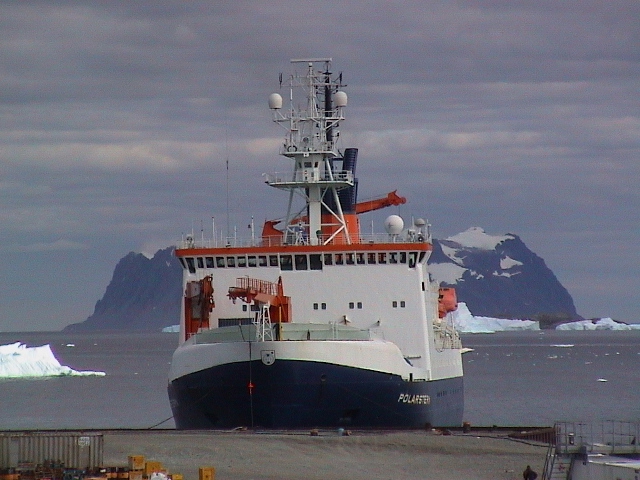
and still more visitors….
